Review of the Terramaster T9-450 NAS Drive
Remember when desktop 9-Bay NAS systems were not a thing? Yeah. It doesn’t seem to long ago that the paradigm of 2/4/8-Bay tower chassis was the status quo, yet over the last few years we have seen 5-Bay systems launch, 6-Bay systems flourish from all the established NAS brands and Terramaster continues to push forward with it’s growing range of 9-Bay tower devices. The new T9-450 is technically their 4th (really, their 3rd) and in the short time they have been in production, they have been very popular. Bringing a rackmount aesthetic and build quality to the humble desktop design we are used to, these were part of an arguably long-overdue chassis redesign by the brand! The T9-450 is possibly the most business/enterprise targetted entry into their tower NAS portfolio, arriving with a very different CPU than usual by the brand, tremendous network connectivity out the box, yet still attempting to hit a price point that flys way, way under the benchmark of their competitors at Synology and QNAP. This and the T9-450 arriving as an all in one hardware-software solution with TOS 5.1 included will definitely give businesses looking to store alot of data, but access it as quickly as possible, pause for thought! But is the Terramster T9-450 all hardware and no utility? Is it all sizzle and no sausage? Let’s review the T9-450 NAS and see if it deserves your data.
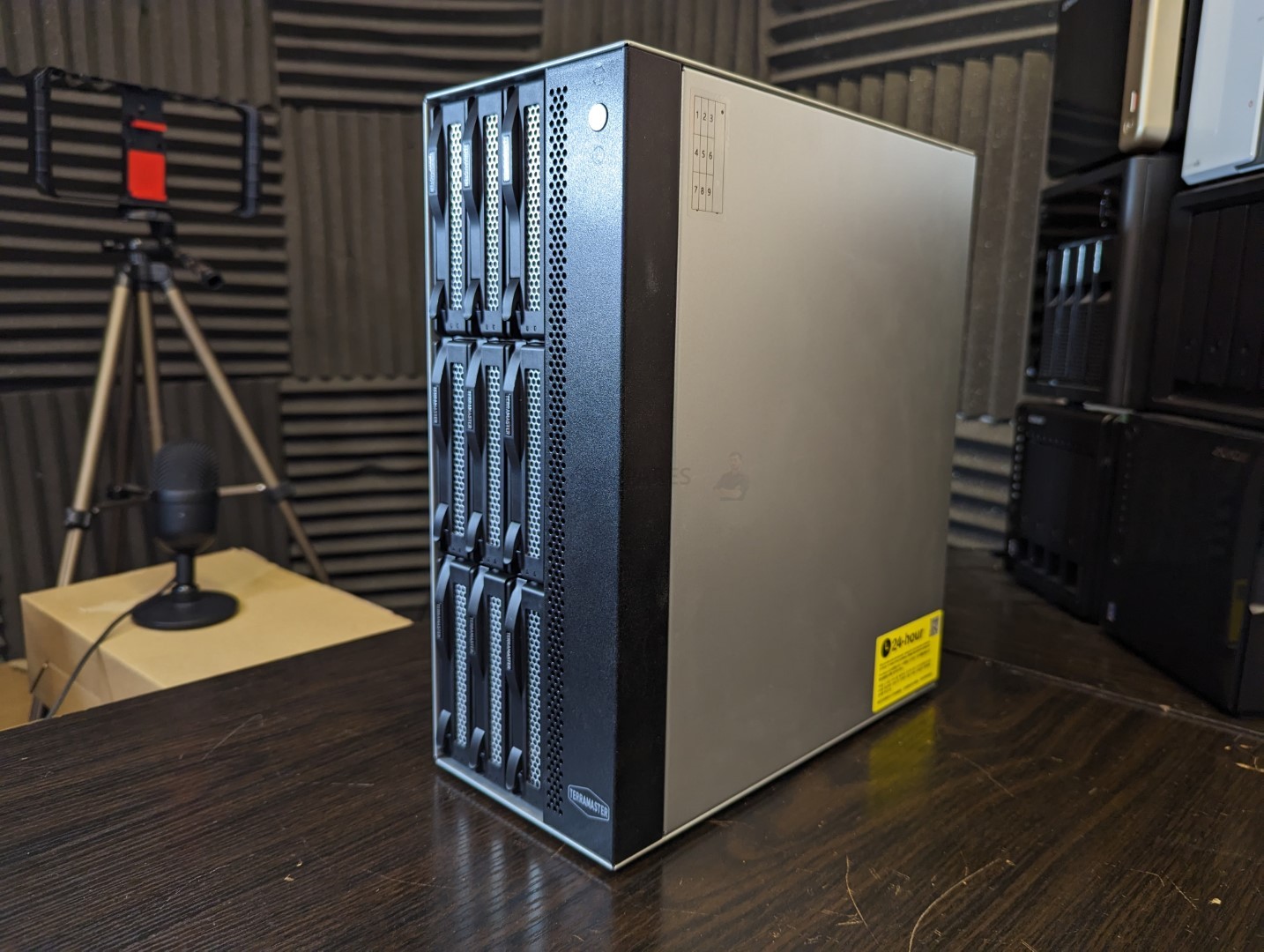
Terramaster T9-450 NAS Review – Quick Conclusion
Terramaster has really changed the playing field with the T9-450 NAS. I was already a big fan of their latest generation of 6-Bay, 9-Bay and 12-Bay desktop chassis – providing a pretty substantial amount of storage in a tower design that borrows ventilation methodology traditionally found in rackmounts, but the T9-450 takes this logic and doubles down on it hard. The dual 10GbE on the system means that, despite it’s comparatively modest price point (when comparing against similar scale solutions from Synology and QNAP) you genuinely have a solution with the potential to allow you to enjoy every single MB/s or GB/s of your RAID externally. This is further bolstered with additional 2.5GbE ports, m.2 NVMe bays, uncomplicated support of HDDs/SSDs and just generally a very sensible system that shows how much Terramaster has matured as a brand. The TOS software is still not quite up there with Synology’s DSM or QNAP’s QTS in terms of ease of use and AAA+ features, but it is definitely a great entry point OS that has tighted it’s security since the brand was targetted by a ransomware group (along with other brands, they were affected by Deadbolt attacks) – it certainly lacks some of the background optimization of it’s competitors, but then this is reflected in the budget of the system too. The internal PCIe slot that has been largely ignored is a bit of a missed opportunity and I am not a big fan of how they have addressed memory compatibility, but overall it is very, very tough to criticise the T9-450 NAS when you factor in the value of the package here. Factor in that you can very easily swap out the OS for many others, and it largely silences alot of the negatives here too. Overall, the T9-450 could potentially be the best NAS that Terramster has ever released and if they continue to address later releases with the same level of hardware value, this could definitely give the bigger names in the industry something of a headache down the road. I highly recommend this system for its value and performance potential!
Where to Buy a Product





![]()
![]()

VISIT RETAILER ➤






![]()
![]()

VISIT RETAILER ➤






![]()
![]()

VISIT RETAILER ➤






![]()
![]()

VISIT RETAILER ➤
Terramaster T9-450 NAS Review – Unboxing, Packaging & Presentation
Although the TS-9-423 NAS is a new device and there have been tweaks in its presentation, things have remained largely the same as with the packaging and protection in older units – only more so! As this is a more affordable solution, it is understandable that some areas of the retail package are going to be a little understated. Additionally, NAS systems like the T9-450 NAS are going to 99% of the time be purchased online (not in your local I.T shop or generally in line of sight at the point of sale), so the need for flashy packaging is less important. That said, many brands still put a little effort into this and present their solutions as a means to promote a brand, lifestyle or general vibe or excellence in their product (i.e. “the first bite is with the eye” etc). The Terramaster T9-450 arrives in a very plain brown box and just has the model ID with a sticker and the brand logos.
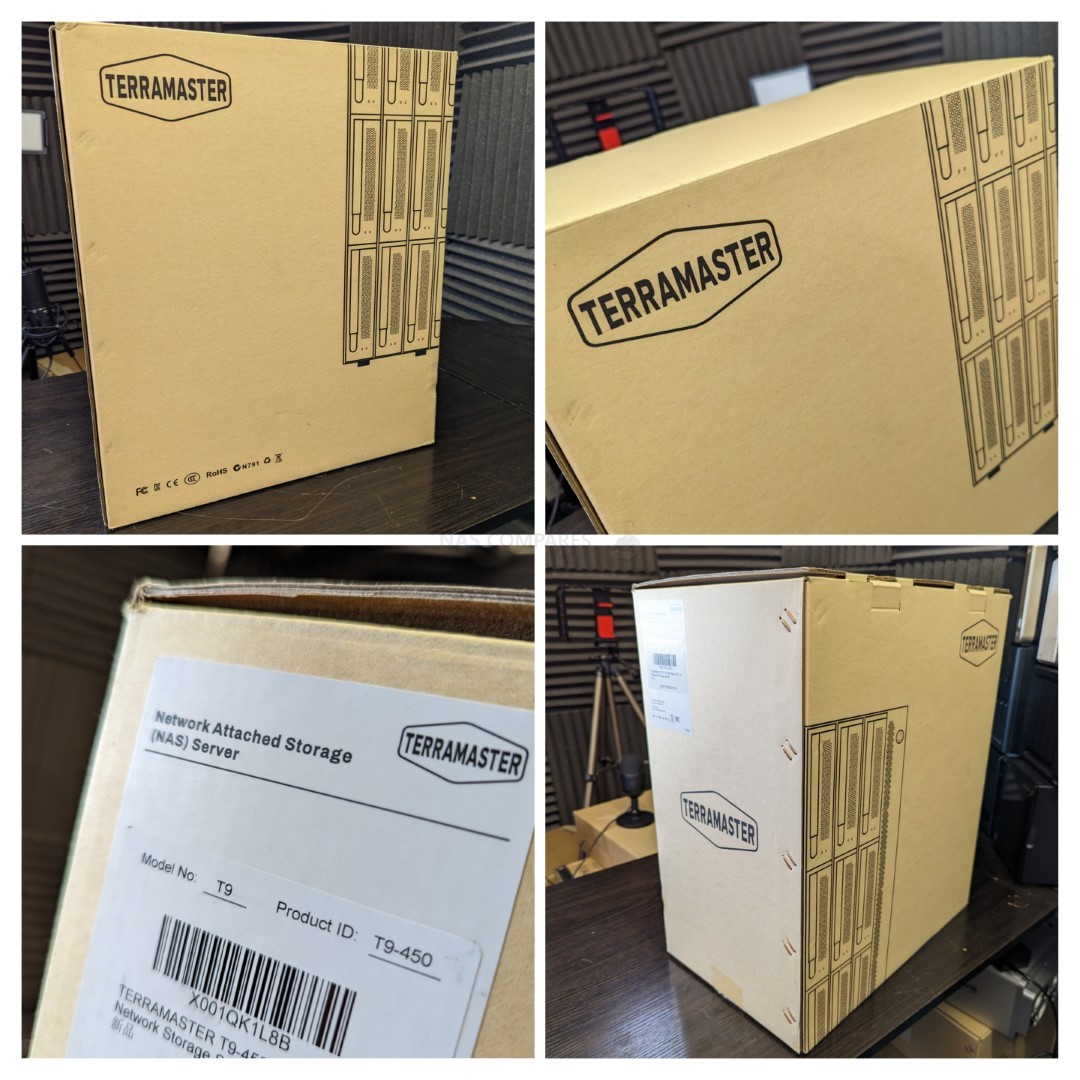
Remarks of presentation aside, the packaging of the Terramaster T9-450 is pretty good in terms of protection. The unit is well held in foam (much thicker than normal and completely encasing the T9-450) and the accessories are neatly and securely contained. There is practically no room for the system to move in transit and ultimately, that is all that matters (silent shock/motion damage to the components).
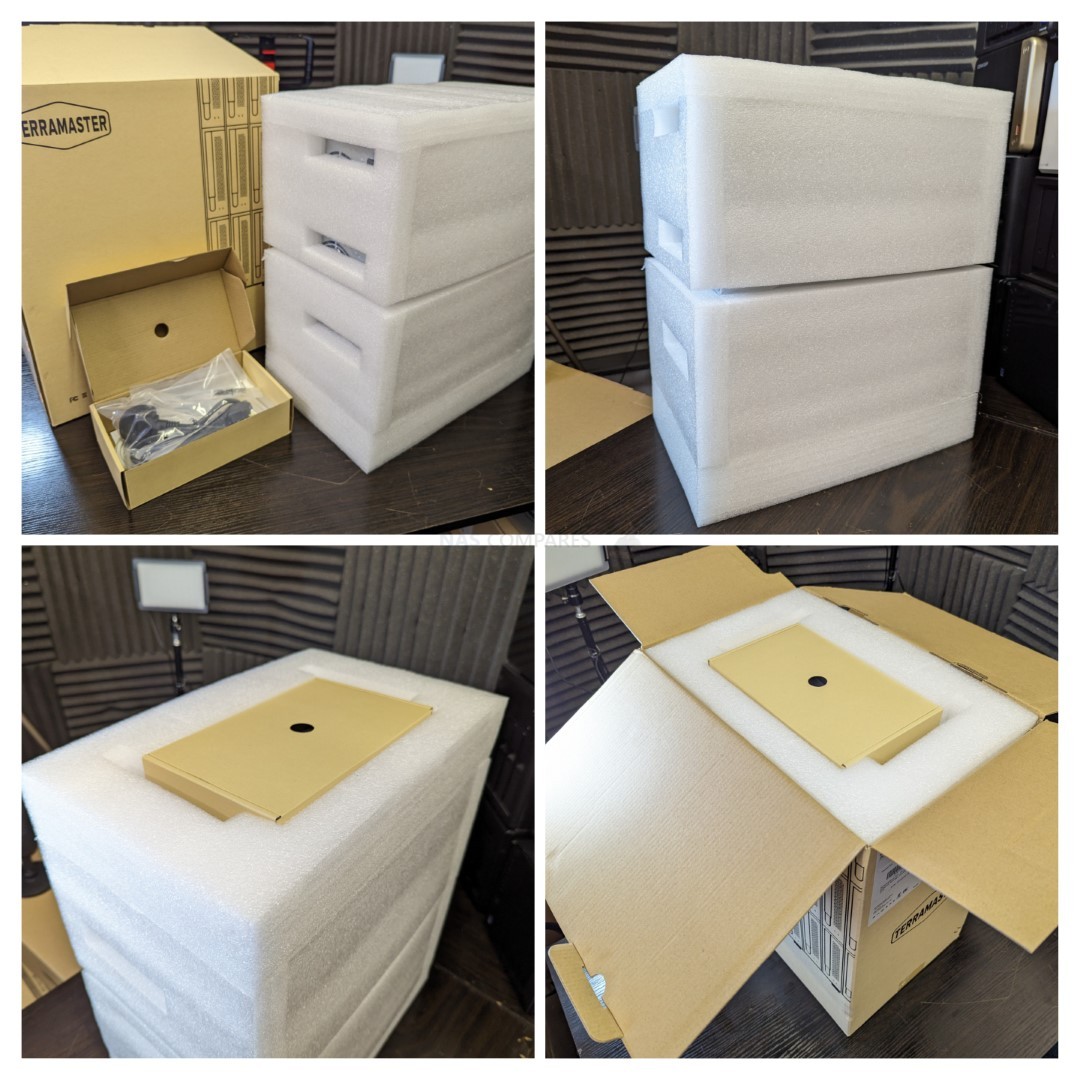
The accessories box contains lots of accessories and although most are pretty standard (setup instructions, power supplier, warranty information, screws, etc), there are a couple of unusual additional that I have never received in other brand’s products, namely the inclusion of additional HDD tray clip/screw washers and additional rubber feet for the NAS. This isn’t really a good/bad thing and for those that need them, it’s a handy addition. It just seemed an unusual addition.
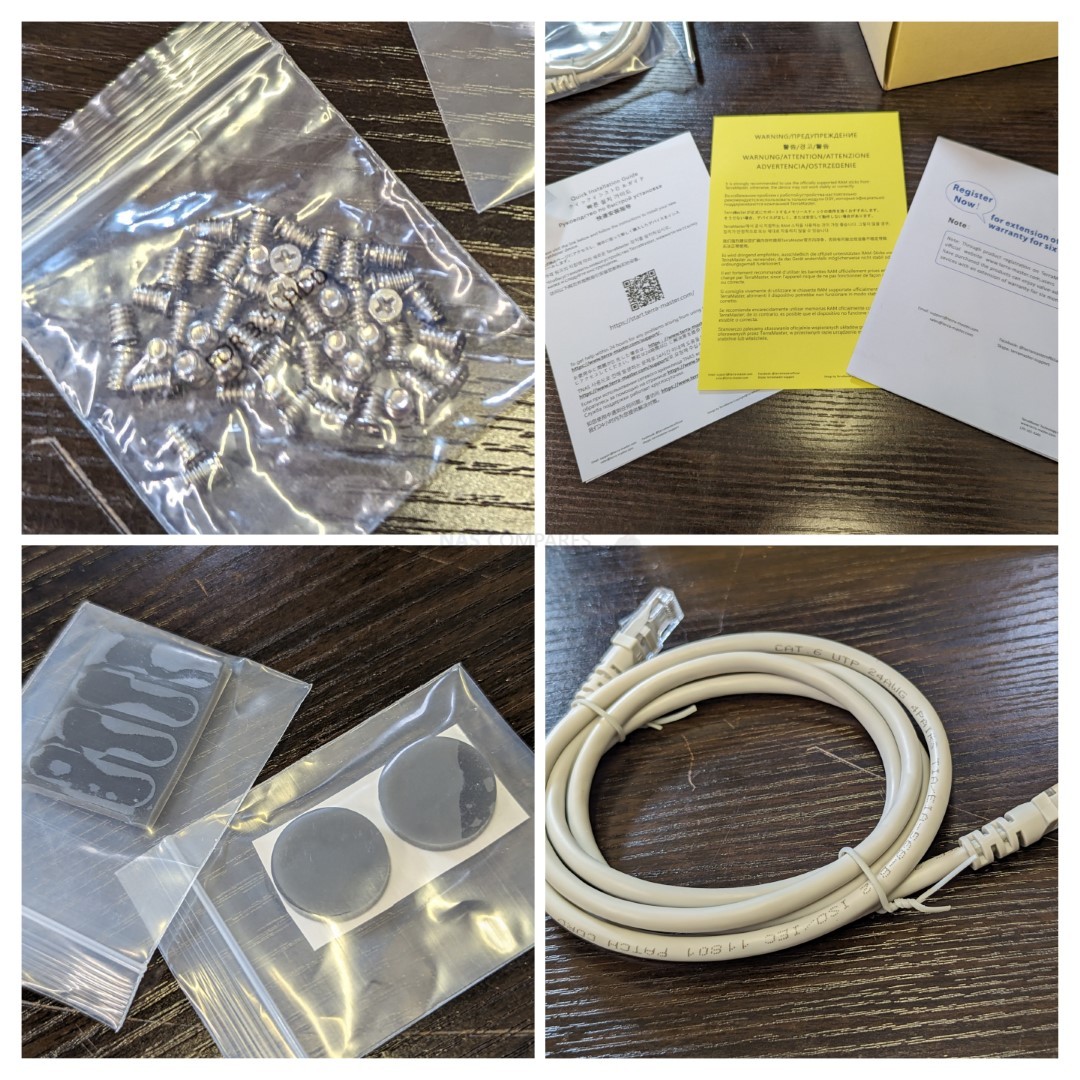
One small but positive area of note is the LAN cable included. As mentioned earlier, in more affordable NAS solutions (like more tech), the way savings can be made is by cutting corners. Therefore I was surprised that the Terramaster T9-450 arrived with a surprisingly high-quality LAN cable. Thick, Cat 6 and very high quality at the connector. Again, this is a small point, but companies such as QNAP and Terramaster HAVE provided Cat 5e cables of a shorter length, thinner material and nowhere near the quality of this one with their 1/2.5GbE solutions. It’s a VERY minor point, but this is the sort of area I would have assumed Terramaster would have saved a few £/$ on and I am impressed. That said, I am a little surprised at the note that was also included with the retail kit:
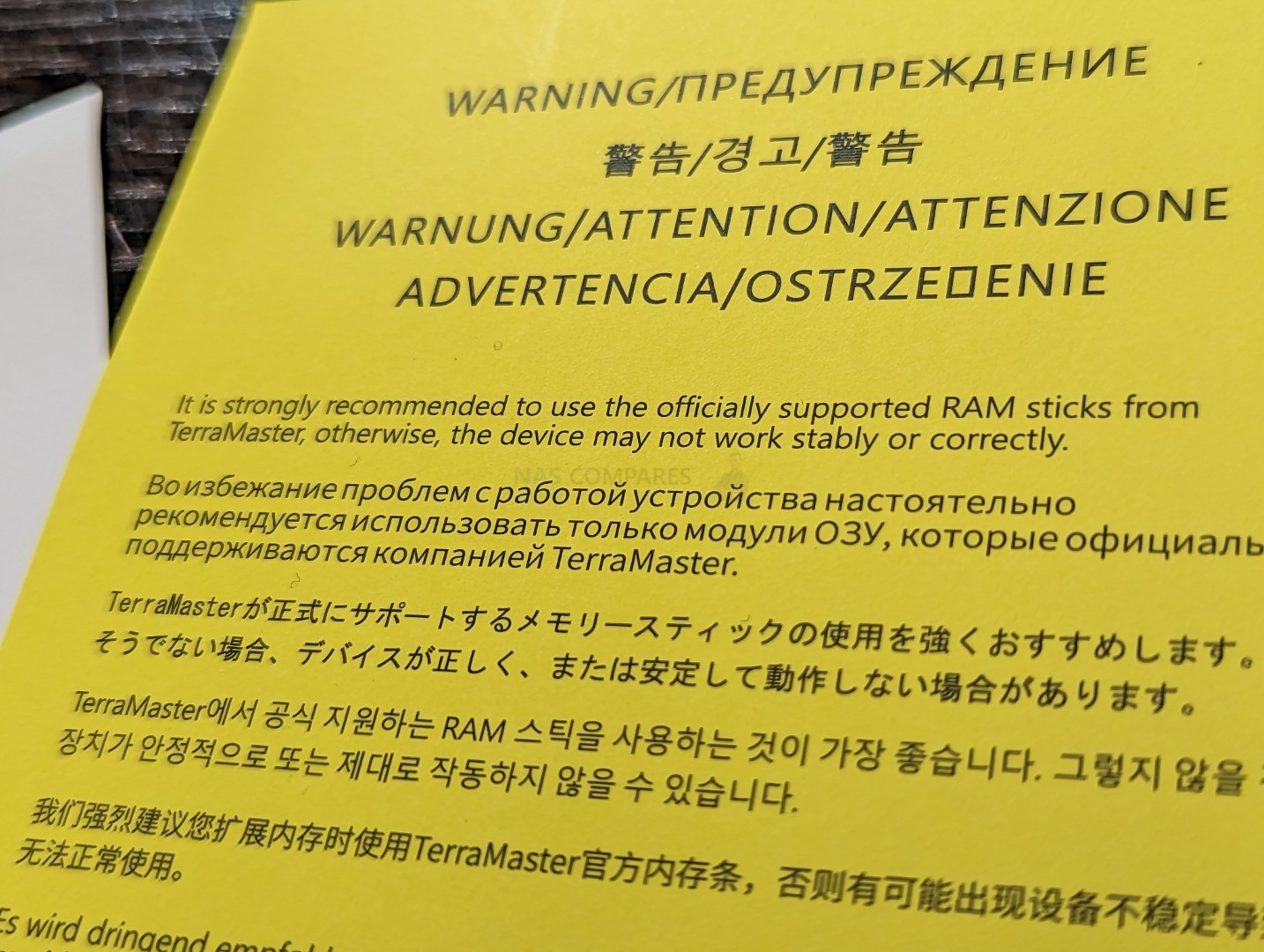
Now, it is NOT unusual for a NAS hardware solution provider to recommend that end users choose to use their own first-party upgrades – practically all the brands do this. However, currently only Synology make a big noise about only using their own first-party memory upgrades as opposed to 3rd party memory from Kingston, ADATA, Crucial, Kingston, etc (arguably to divisive results with their Home/SOHO/SMB user base). Therefore I am a little surprised that Terrmaster include this note. It’s worth highlighting that they are not stating it as a ‘make or break’ position on warranty and/or support by them, but still – not a big fan of these kinds of warnings, as none of the NAS brands (Terramaster included) actually produce the memory inside their systems. The Terramaster T9-450 arrives with an internal 250W PSU, so no external power brick for this particular desktop NAS drive. Overall, there is quite a good range of accessories included with the Terramaster T9-450. Nothing spectacular, but pretty much everything you are going to need (aside from storage media) to set up your NAS quickly and easily. Let’s discuss the design of the T9-450.
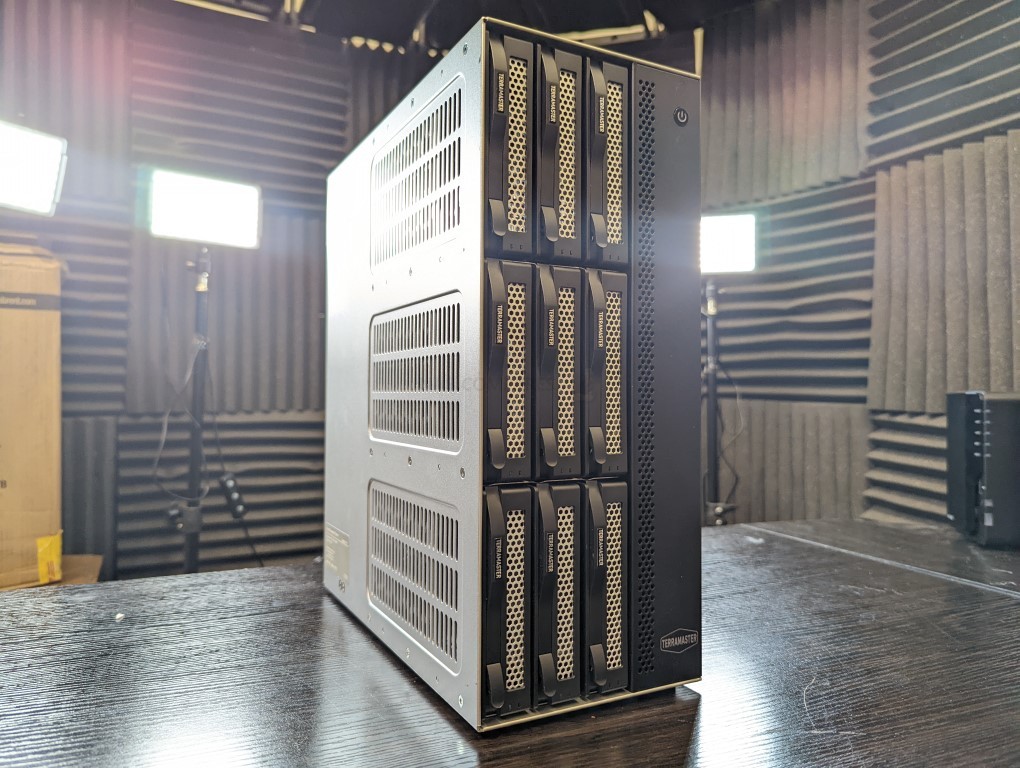
Terramaster T9-450 NAS Review – Design
The design of the Terramaster T9-450 NAS is largely identical to that of the T9-423 released a few months ago, which I reviewed here and was already kind of keen on for its compact, yet rugged structure. For quite a long time, full high PC-Case style chassis were considered a little dated, but the T9-450 is more more stylied on a rackmount chassis, but in a vertical deployment. What I mean by that is that the horizontal ventilation design of a rackmount is implemented here in a desktop chassis, but the actual physical desk/table space being occupied by the 9 bays of storage is actually only 13.5cm x 29.5cm – smaller in desk space footprint than a standard USB keyboard. You of course have to factor in the height, but compare this to most 6-8 bay devices in the market in desktop form, and in many ways, it makes the T9-450 easier to deploy.
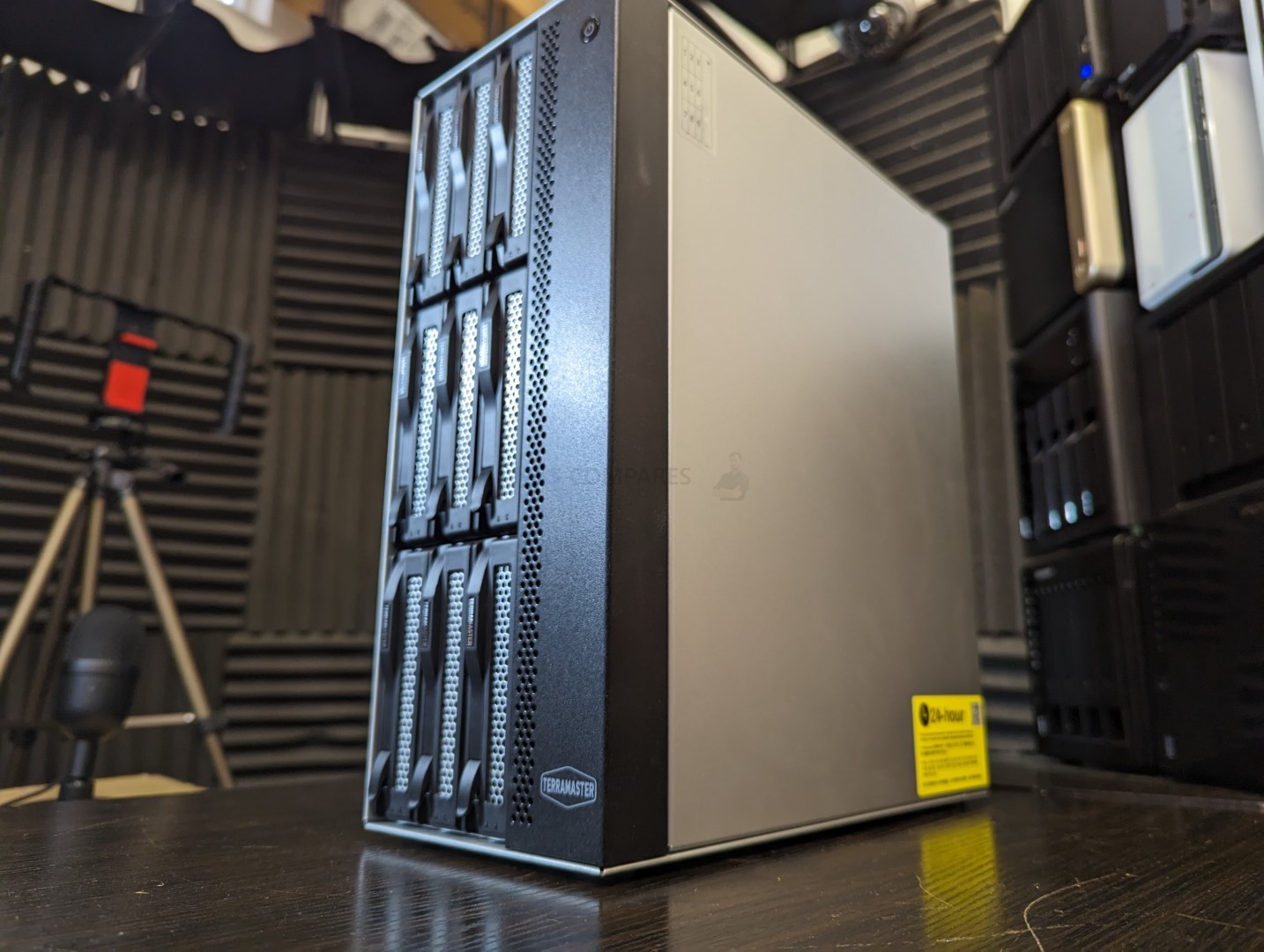
The complete chassis measures 334 x 135 x 295mm and around 70% of the available space is occupied by those 9 bays of storage. Although the pictures make this system look about the size of a normal PC case, it is actually a bit smaller and I was a little surprised by the scale of the system when I had my hands on it. Only one side panel can be removed (the right side, which allows access to the main motherboard for M.2 NVMe SSD access and Memory upgrades) and the overall build quality is quite high.
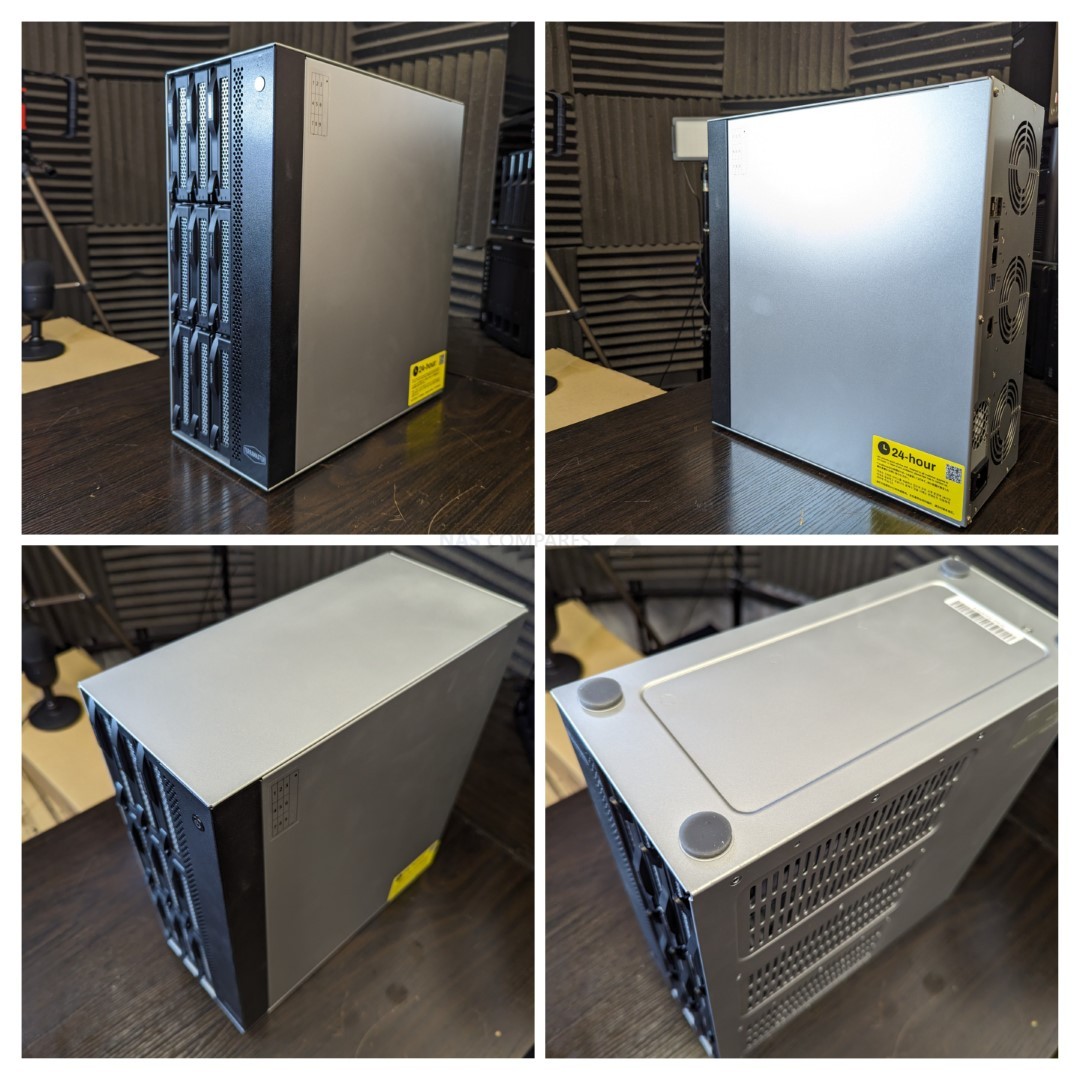
Of course, an important factor when it comes to the smooth running of this scale of storage is the cooling and ventilation afforded to the system when in use. I am pleased to confirm that the Terramaster T9-450 NAS features a tonne of ventilation throughout. Each of the bays has a metal vented panel on the front, the area above the storage with the CPU+Memory etc has its own ventilation strip, the side of the casing that is closest to the storage media has a HUGE area of ventilation and all these are being utilized passively with the three active rear cooling fans.
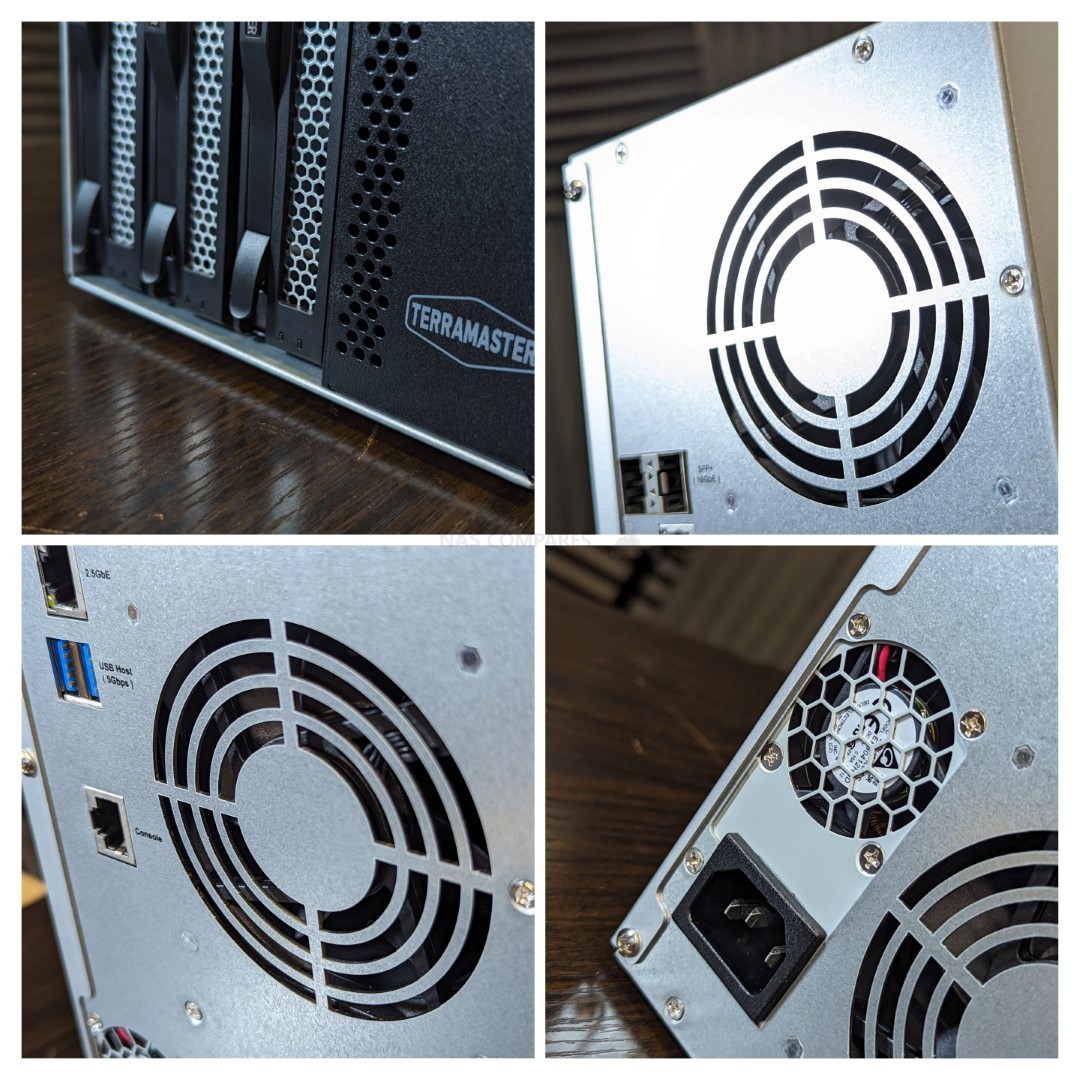
Storage media is easy to install and the system takes advantage of the popular RAID configurations (RAID 1, 5, 6, 10, etc) that the user might want to opt for. Additionally, the system can be operated with as little as a single storage drive if you want, then add drives to the storage pool gradually if you prefer. This is particularly advantageous when you note that Terramaster TOS 5 now includes TRAID – a flexible and less rigid RAID system that allows you to use mixed drive capacities in a single RAID pool, as well as making expanding storage in general much easier. The trays of the Terramaster T9-450 NAS themselves are metal, springloaded, but not lockable. They are not click-and-load screwless drive trays, but that’s hardly the end of the world and Terramaster include all the screws you will need.
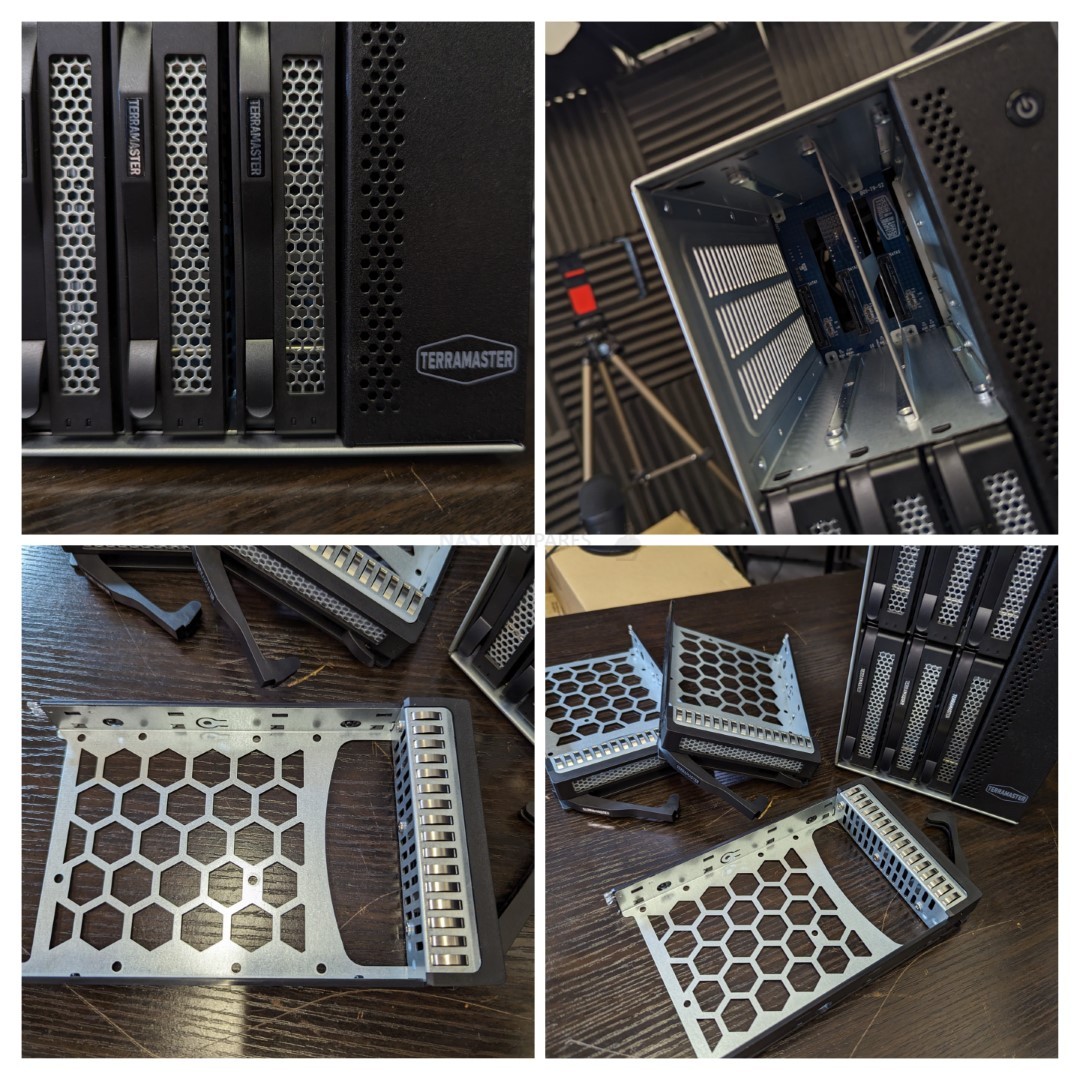
Each of the bays are SATA connected (combined data+power) and are hot-swap enabled, so no need to power down the system when connecting a new drive to a RAID for expansion or RAID repair on the fly. Each row of three drives feeds into a multi-lane cable and then directly into the motherboard (as opposed to the NAS having a separate storage board that is connected to the motherboard with a PCIe slot/angle connector as in smaller NAS systems. This is a clean and intelligent piece of design here and, again, not something we see alot of on desktop NAS devices (it is much more popular in larger rackmount design)>
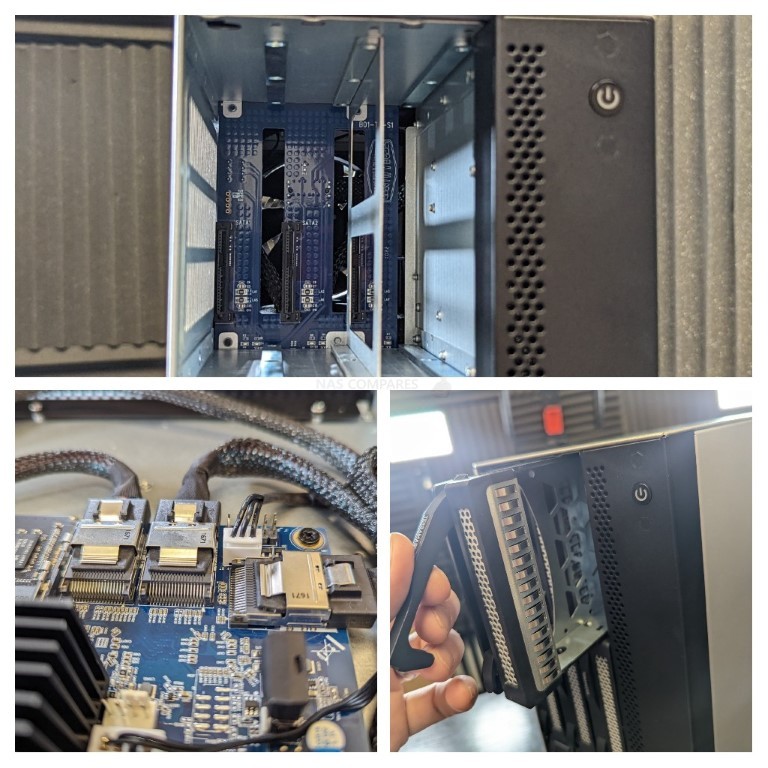
One thing about the design that we DO have to discuss a little more is the actual deployment. Opting for the vertical 3×3 arrangement of drives does mean that this device is going to be very tall and many users might have wanted something shorter but wider (i.e like most 8-Bay NAS systems). The base of the system has 4 large rubberized feet that lift the system up for whichever desktop surface it is placed on by around a 0.9cm. This is fairly normal BUT is it possible to deploy the Terramaster T9-450 NAS horizontally – i.e on it’s side, so it looks a little more like a compact rackmount that you deploy on your table top?
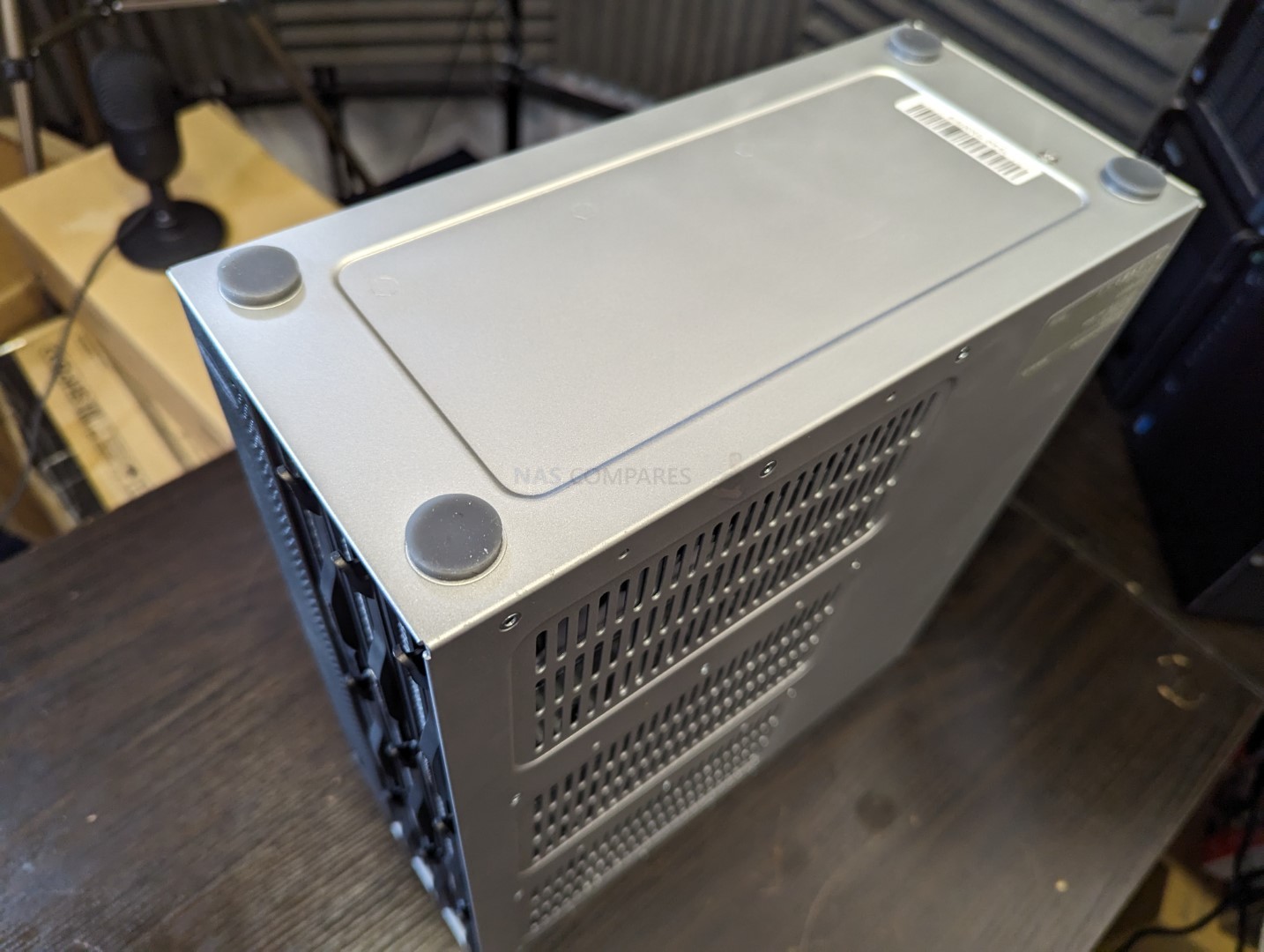
Well, yes, sort of. Inside the accessories kit you find a pack of additional rubber feet and although there is ZERO mention of this being so you can deploy the Terramaster T9-450 NAS in a horizontal fashion, it is not particularly hard to do so and these will ensure that the side of the chassis with all those HDD ventilation is raised up from the desk (much like it is with most other desktop NAS).
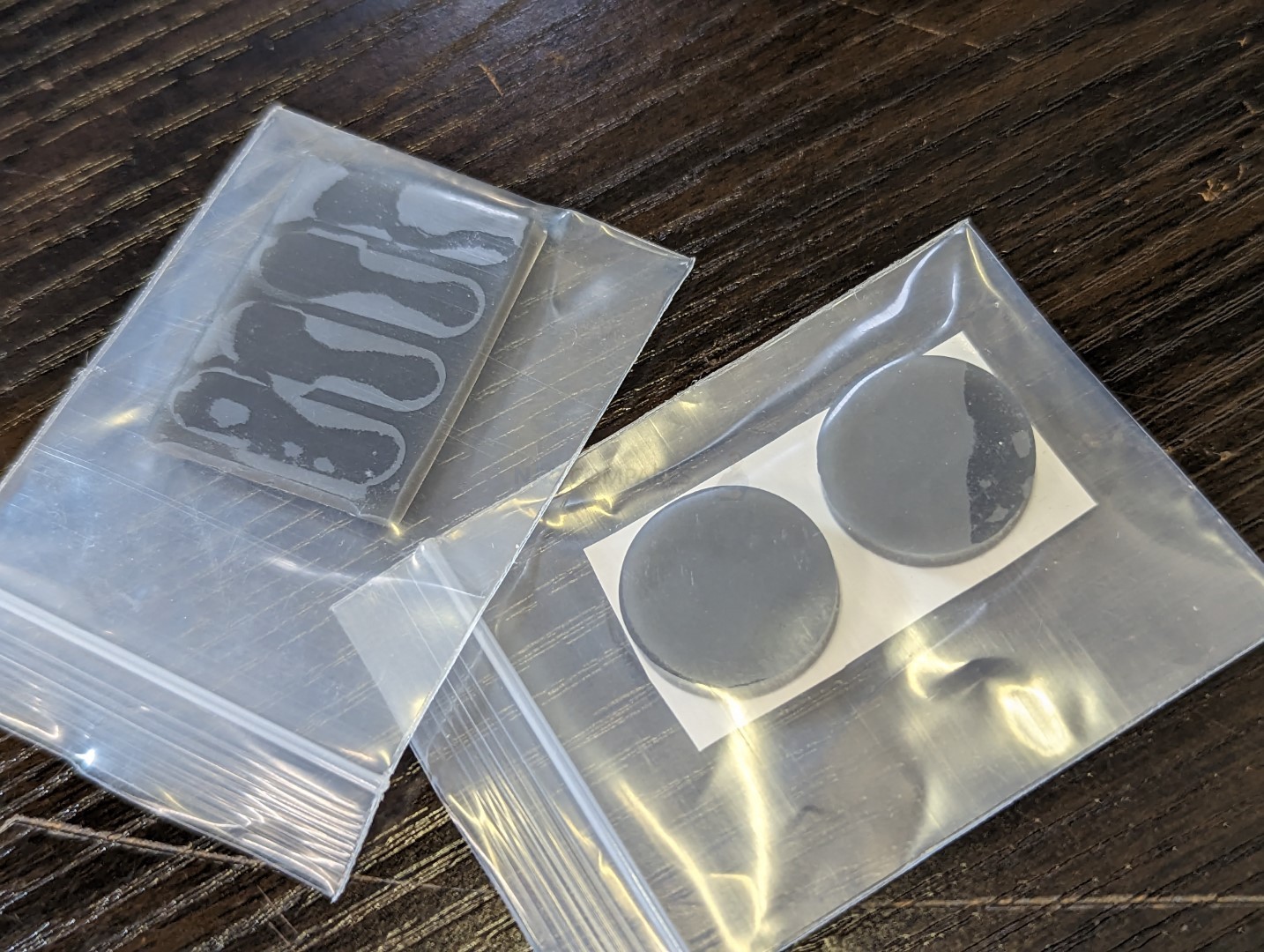
When it is on its side, it looks surprisingly neat. Again, very much like a compact rackmount chassis and I can DEFINITELY see some users opting for this style of deployment of the Terramaster T9-450 NAS. The only issue I can foresee here is that the network ports will be at a 90-degree angle (hardly the end of the world).
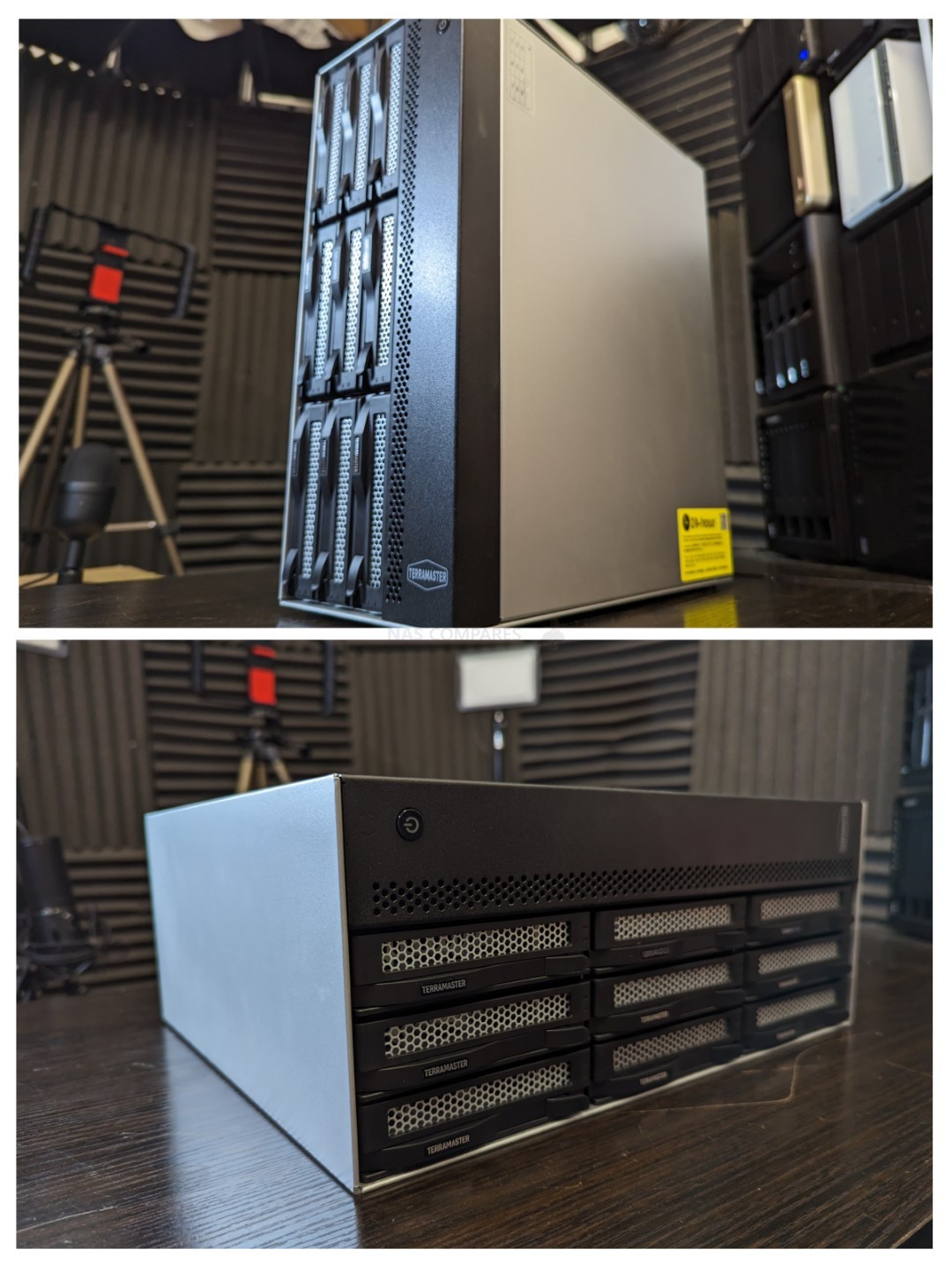
Overall, I have to say that the design and build quality of the Terramaster T9-450 NAS was considerably higher than I thought it would be and I very quickly grew accustomed to the unusual design and saw its merits. Additionally, the build quality here is considerably higher than other smaller Terramaster desktop NAS chassis. Let’s discuss the ports and connections of the Terramaster T9-450 NAS to see if this NAS continues to impress.
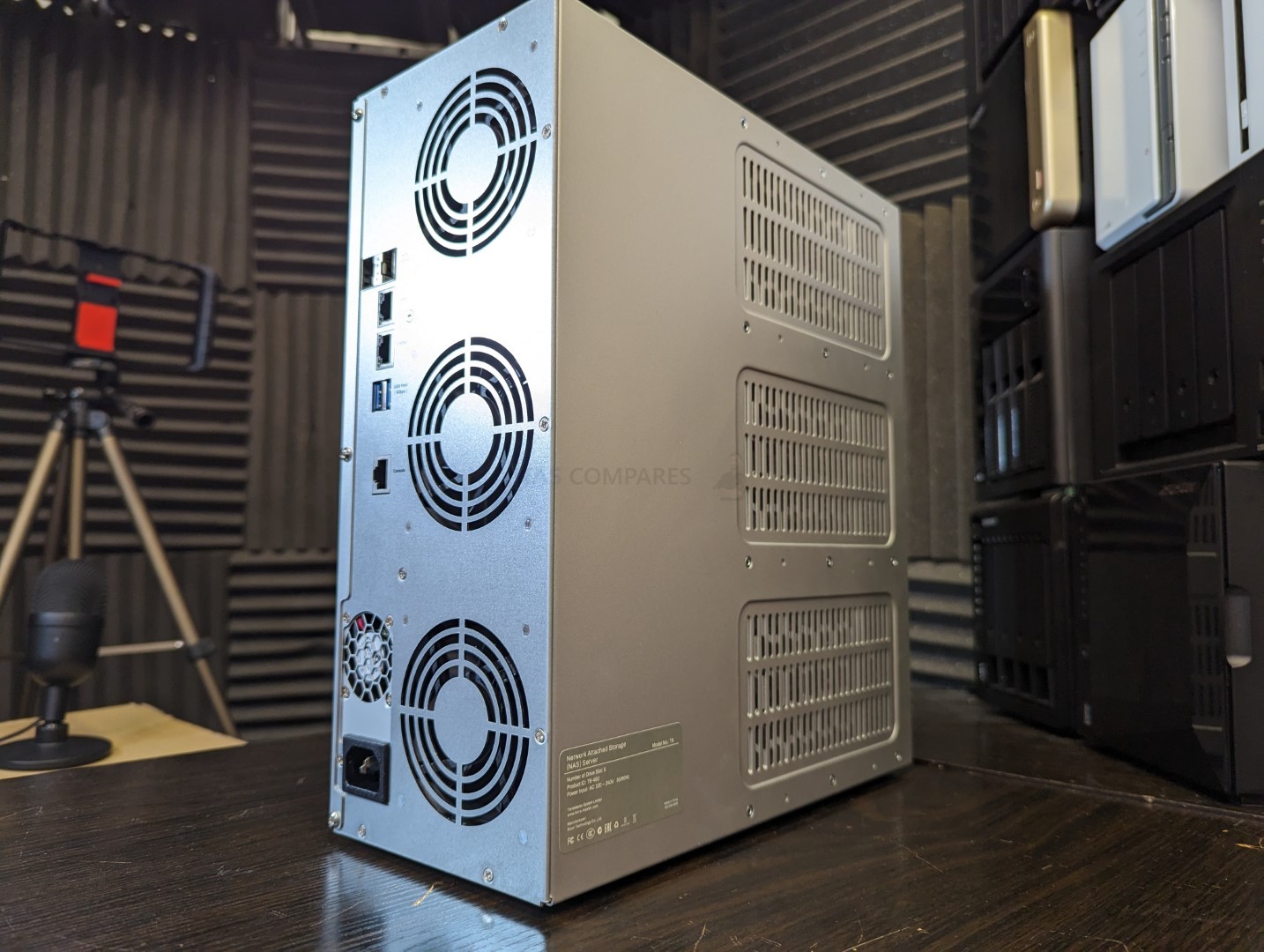
Terramaster T9-450 NAS Review – Ports and Connections
The connectivity of the Terramaster T9-450 NAS is probably one of the strongest points of its appeal to those looking to make the most of those 9 SATA bays. It lacks any real graphical output (largely down to the lack of an integrated gfx processor), but unlike the T9-423, the T9-450 is clearly designed to be more of a throughput workhorse! Despite it being a compact desktop NAS, the system still uses an internal PSU – A 250W removable block (not bare power board and transistors). It is a very clean install and is surprisingly well spaced from the rest of the system hardware.
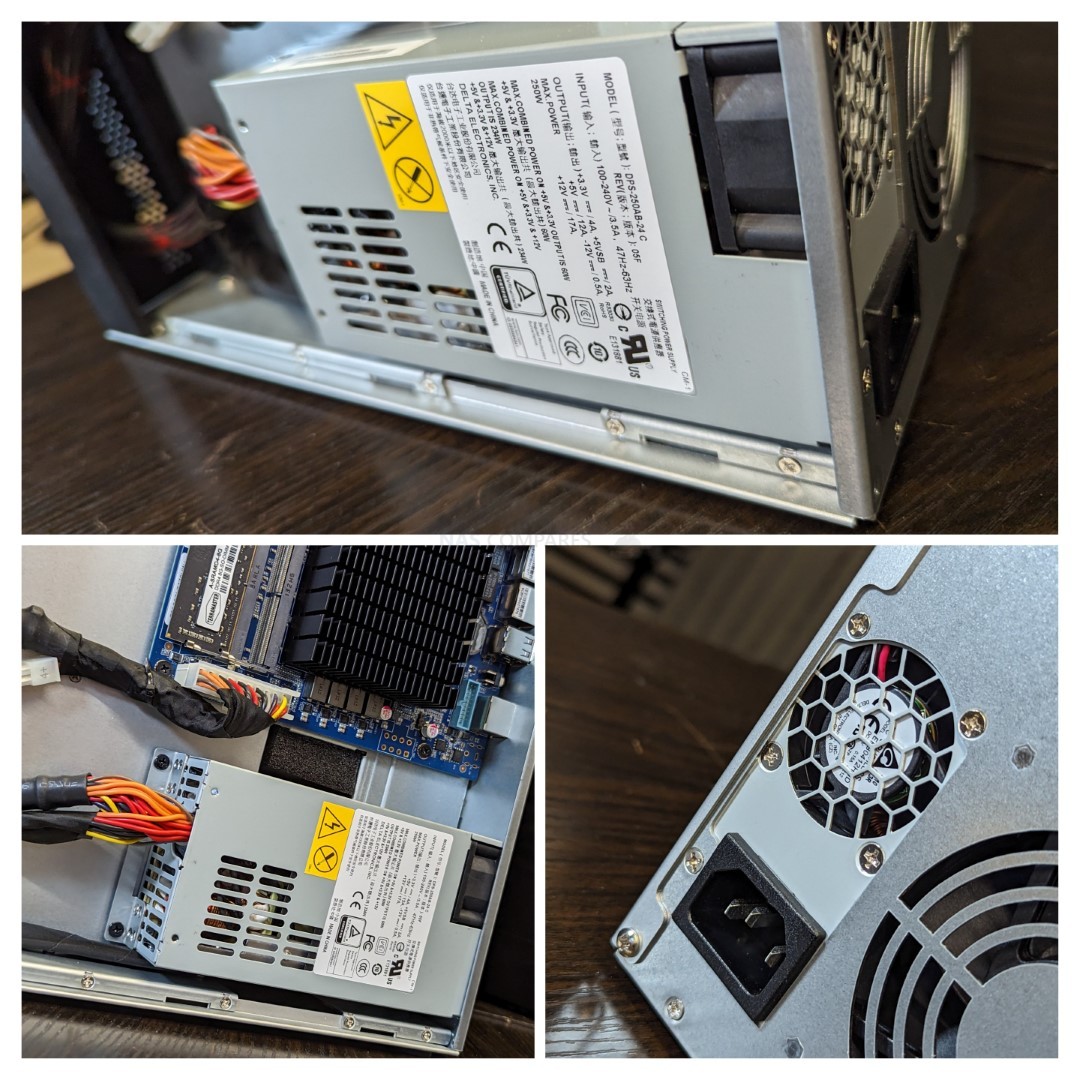
Of course, the first big improvement of the Terramaster T9-450 and x423 series has over its predecessors in the brand’s desktop portfolio in recent years (F4-422 and F5-422) is the inclusion of 2.5-gigabit ethernet (2.5GbE). The NAS arrives with two ethernet ports that can provide around 250-279MB/s throughout each, as well as allowing link aggregation (aka Port Trunking) to combine their bandwidth and provide 5GbE (around 500-550MB/s throughput) with the use of a smart switch. In the last few years, we have seen several brands provide 2.5GbE connections at the same cost as 1GbE ports and with internet service providers and affordable switch manufacturers providing 2.5GbE solutions, it was only natural that NAS brands would make the jump towards it. Hypothetically, if you had a faster than Gb internet connection (fiber etc) and a google drive account, that means that you would be able to connect with your cloud drive FASTER than a NAS system in your home if you only have 1GbE. This is why NAS systems need to arrive with 2.5/5/10GbE in 2022, for the sake of futureproofing and to keep up with the growing demands for data access. Additionally, 9x SATA storage bays (as well as the internal SSD bay that I will touch on later) will easily saturate a 2.5GbE and even LAG-supported 5GbE connection, so these ports allow you to maximize your storage potential and share that bandwidth with multiple connected users. However, it does NOT stop there.
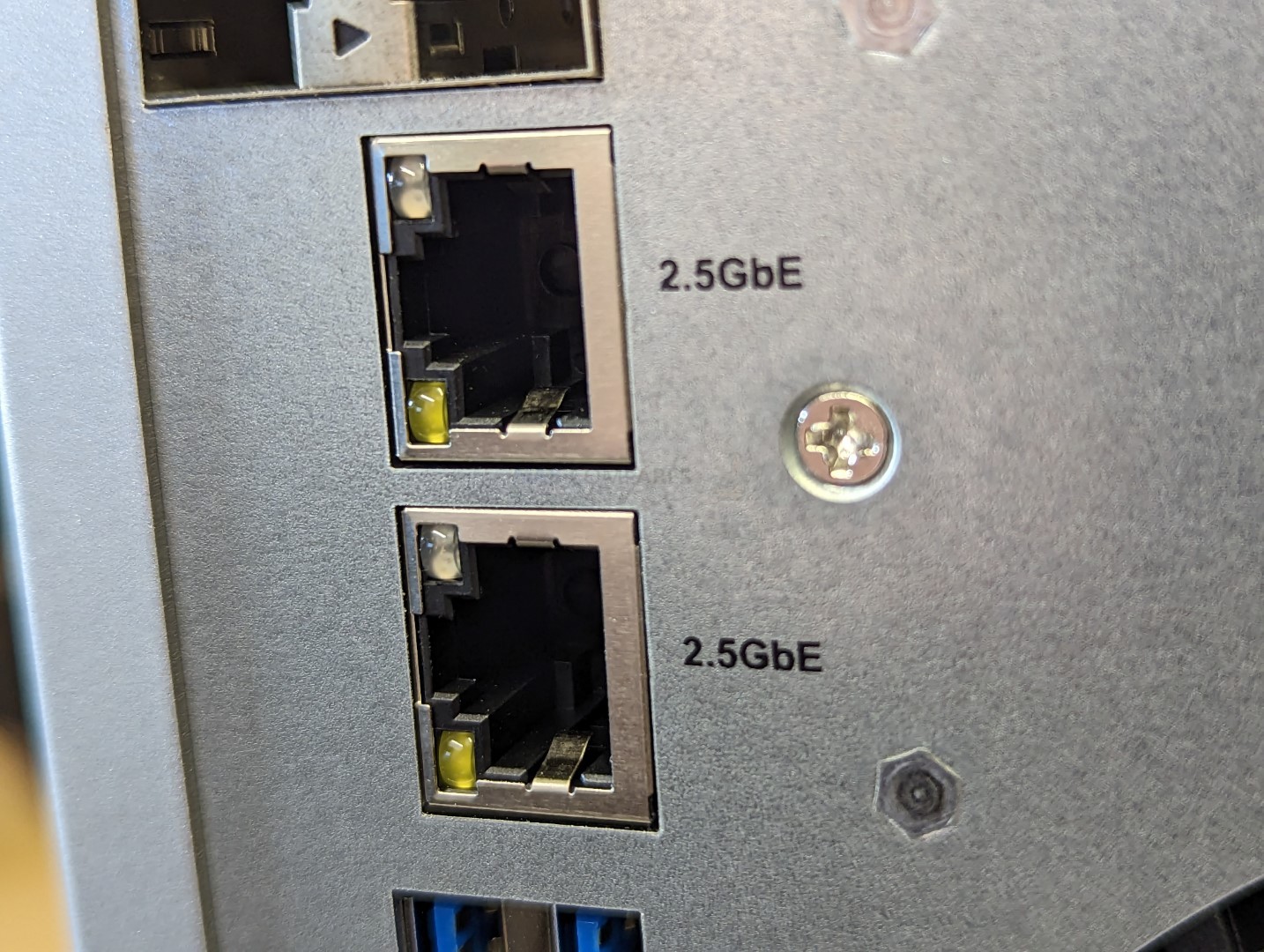
That’s right, the Terramaster T9-450 arrives with two.. TWO 10Gb ports! That brings the total potential external bandwidth potential connectivity of the T9-450 to 25GbE when appropriately connected to the right switches/network adapters locally. That is INSANE for this price point and even if you fully populate the device with SATA SSDs, I still am not sure you could fully saturate that bandwidth without also including a couple of expansion devices! Now, they are Fiber/SFP+ based 10Gb, so you are going to need transceiver adapters, DAC pre-attached cables and/or RJ45-to-SFP+ adapters in order to capitalize on this bandwidth, but alongside the CPU, this is one of the things about the T9-450 that clearly marks its focus towards businesses who want serious storage and throughput concerns to be eliminated.
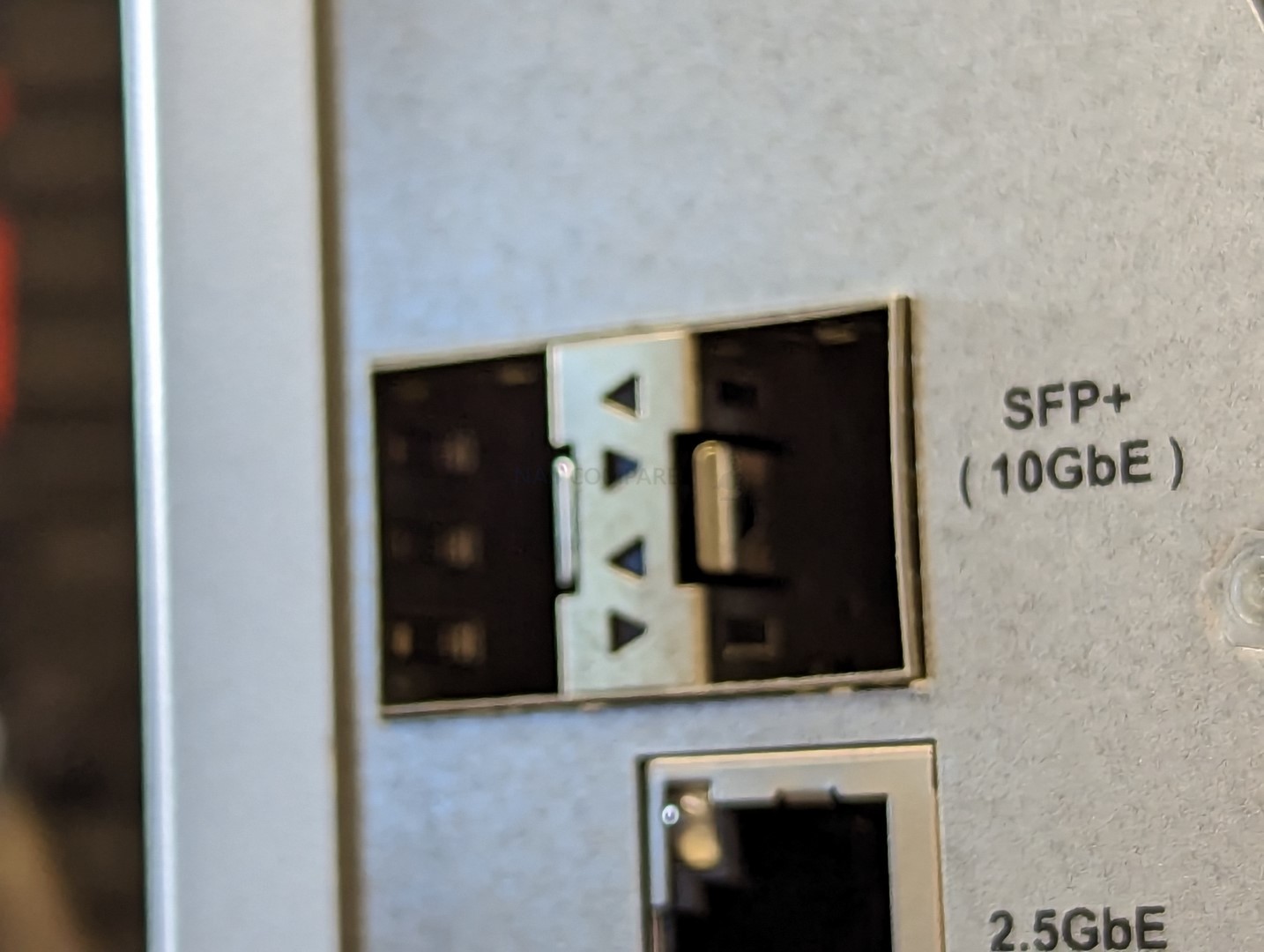
Whether you are considering the T9-450 NAS for your data so you can go ‘balls to the wall’ with those connections out the gate using a smart 10GbE switch and/or SMB-Multichannel, OR are going to scale towards it at a later date and just use a handful of the SATA bays at the start in a flexible TRAID over 1/2x 2.5GbE at the start, there is a huge element of scalability available in the T9-450 that needs to be applauded.
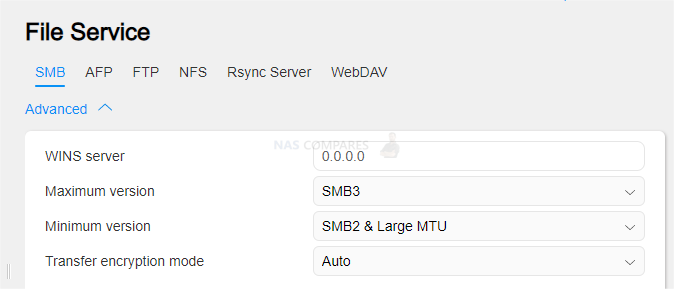
One area I am a little underwhelmed by is the USB connectivity of the T9-450. I appreciate that this might be a limitation of the Intel CPU used inside, but the two USB 3.2 Gen 1 5Gb/s ports are a bit of a bummer. We are talking here about a huge degree of storage that can comfortably push transfer rates in 1,000MB/s+ without breaking much of a sweat. But if you connect an external local USB DAS RAID box for a local backup, you are going to be throttled to 500-550MB/s max. Yes, these still support lots of USB appliances (including 2.5/5G-to-USB adapters), but it’s a slightly annoying bottleneck. This is further complicated when you factor in that the T9-450 supports expansion chassis, but they too use USB connectivity – which will also be bottlenecked to 5Gb/s. Less of an issue in external drives under 4-5 bays, but if larger expansion chassis arrive, this will be a bit of a pain. Still, it is almost certainly a result fo the CPU choice and trying to judge the balancing act of performance vs ability vs pricepoint.
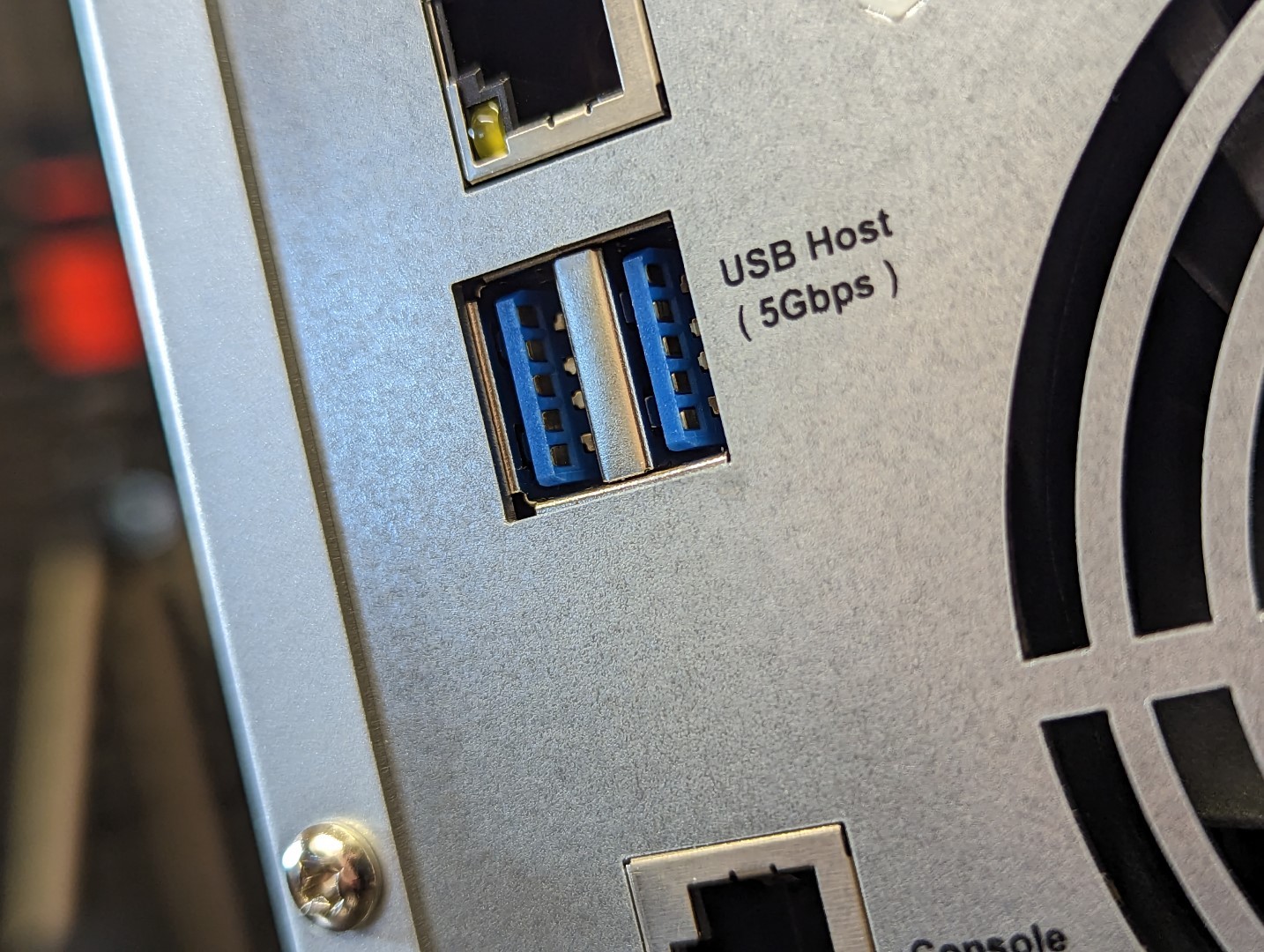
The ports and connections of the Terramaster T9-450 are few in number but still are nonetheless significant upgrades over everything else in the brand’s portfolio. Terramaster could have EASILY cut a few corners here (such as just a single 10GbE or ditched the 2.5GbEs altogether) and most users would not have batted an eye (as it is still lower in the price for its hardware scale than its competitors), but you really are getting a great degree of hardware connectivity here that allows you to capitalize on those 9 bays of storage. Let’s get our screwdriver and take a look inside this NAS to see how Terramster have approached the internal specifications of the T9-450.
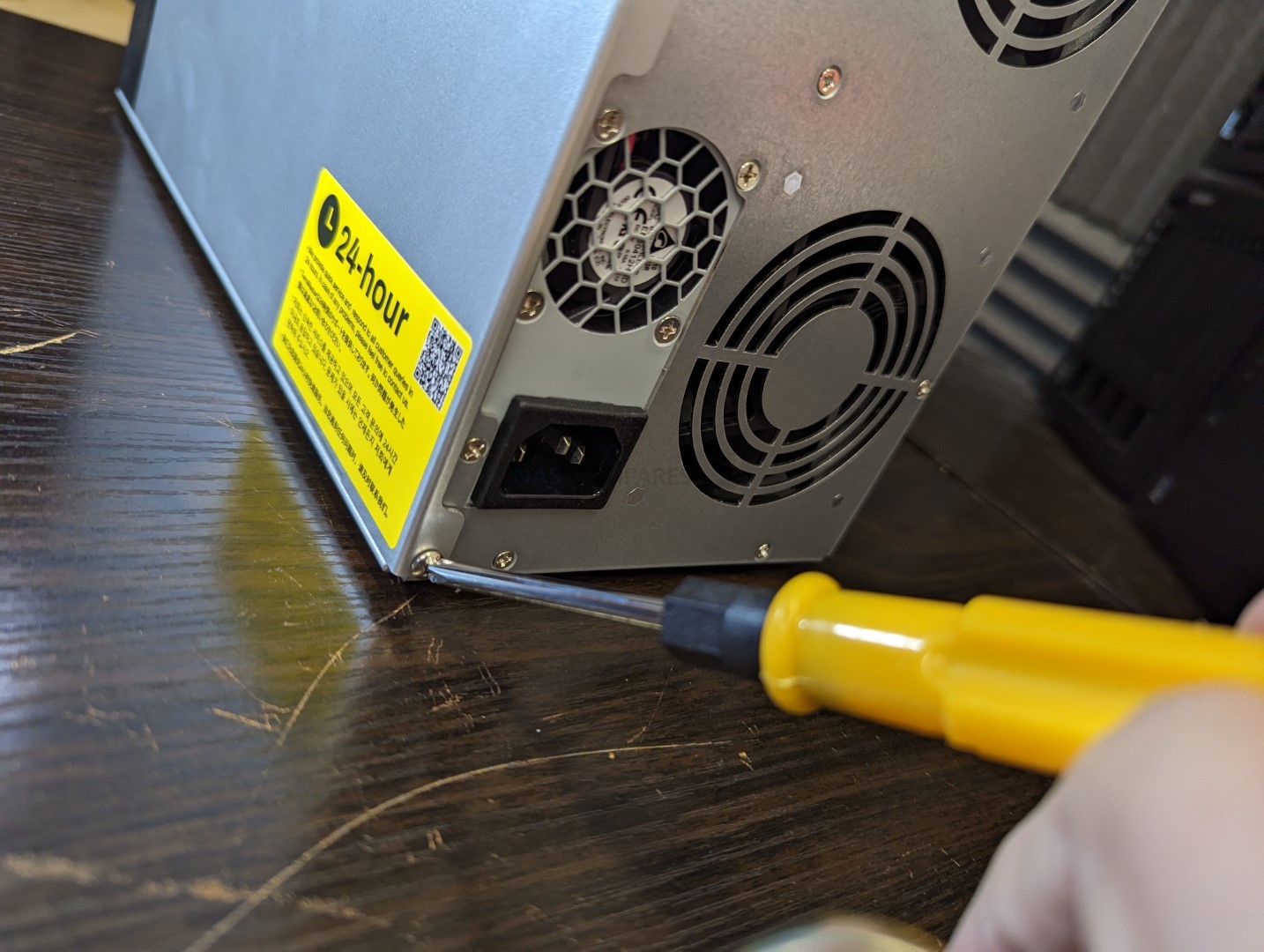
Terramaster T9-450 NAS Review – Internal Hardware
The side panel of the T9-450 NAS is clearly designed to be something most users are invited to do – as the panel uses a hinge mechanic – as opposed to 95% of NAS that use wrap-around chassis design that can be a chuffing nightmare to reattach without getting at least 1 of the key/hooks out of alignment! What you find inside is a very spacious board area, a single controller board and the main bays are on a sister board connected via 90 degree located PCIe connector, with additional multilane cables that host 3x drives each. It’s a very clear setup.
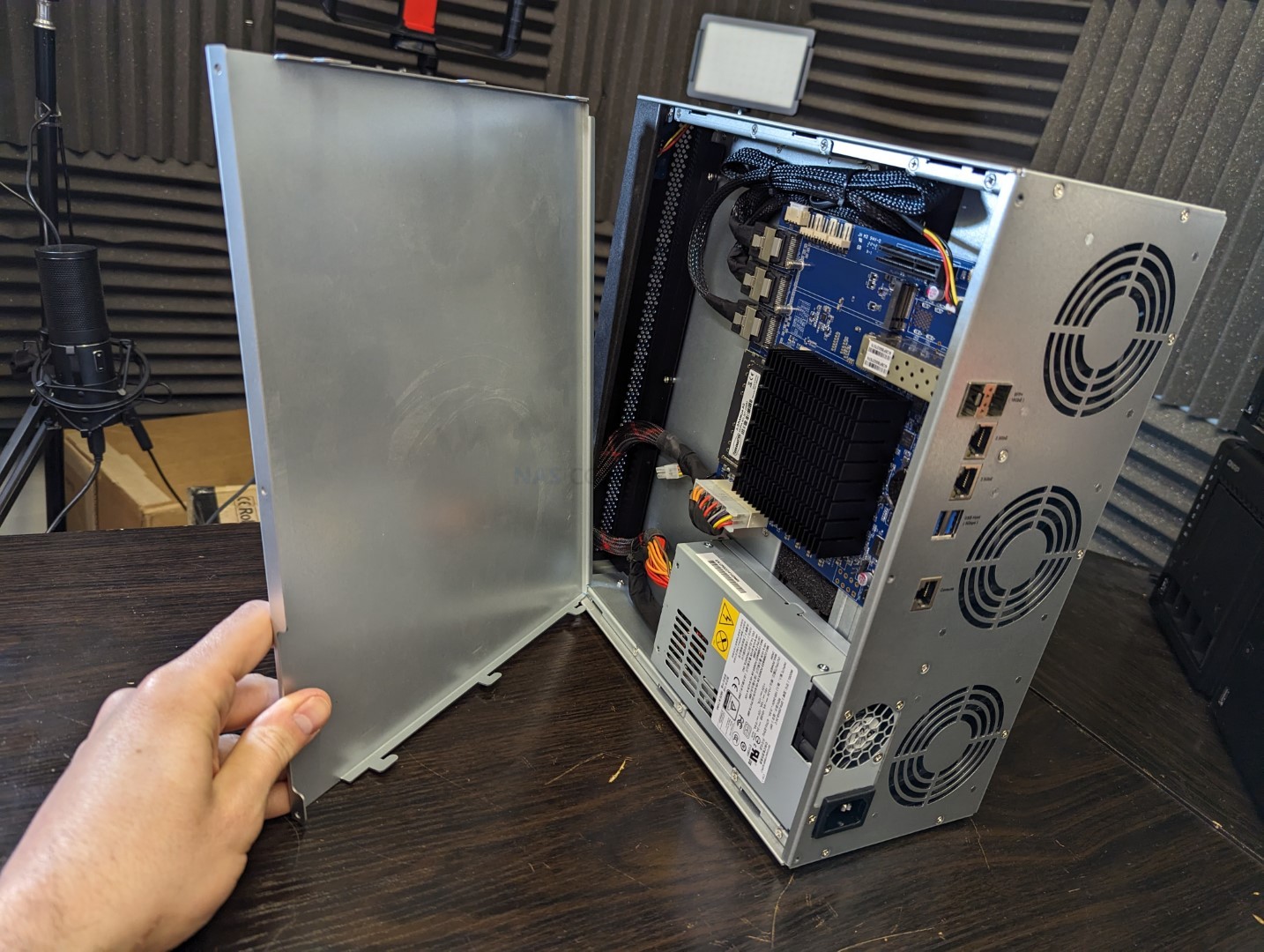
The CPU heatsink that covers the Intel Atom C3558R processor inside is pretty large, occupying almost half the physical space of the controller board! It’s quite a snug fit in between the dual memory slots, the m.2 NVMe SSD slots and the 10Gb SFP+ connectors. I would be interested to see how this affects system temps in the long term, as the three rear cooling fans are directly channelled into the HDD cage array, with these components catching the air flowing around the case. 10GbE (especially dual ports) are going to clock up some high temps! That said, this is also going to be a processor that is going to be a pinch power hungrier than other ones used i nthe Terramaster portfolio. It has a 2.4Ghz clock speed, 4 cores and 4 thread architecture with a TDP of 17W – which is coming close to double the 10W TDP of the Celerons that Terraamster normally use. This is inevitable if you are going to try to hit saturation on those 10GbE ports.
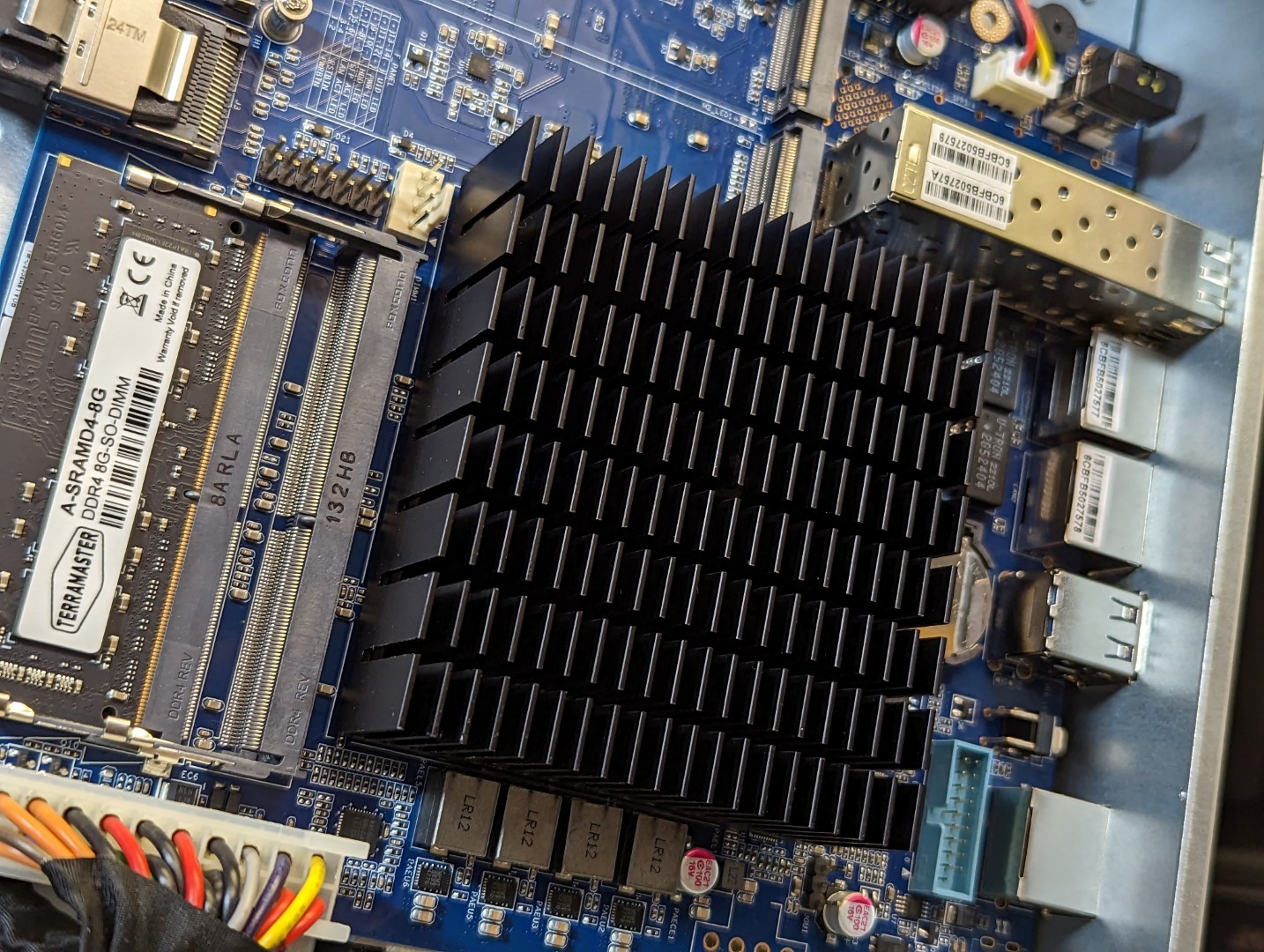
As mentioned at the start, the T9-450 is not the only 9-Bay from Terramaster this year. Prior to this, there was the T9-423 earlier in 2023, which runs on an Intel N5105 Celeron processor. Despite its lack of 10GbE, it does have the same 2.5GbE connections, USB 10Gb/s and embedded graphics allow improved performance on things like transcode/decode/encoding multimedia and graphically targetted data processes. The Intel Atom in the T9-450 counters this with a higher clock speed, being file processing capabilities and trades efficiency for raw power. The graphs below demonstrate the difference between Intel Mobile Celeron N5105 and C3558R most important characteristics. These features, along with an IPC (instructions per cycle) number, determine how well a CPU performs. The “Operating frequency” chart uses dark color to represent base frequency, while lighter area is for extra frequency, provided by Turbo feature. Darker area on the “On-chip cache” graph is for the On-chip L2 cache. Lighter area is for the L3 cache cache. Although the L3 cache is usually larger than the On-chip L2 cache, it is always slower.
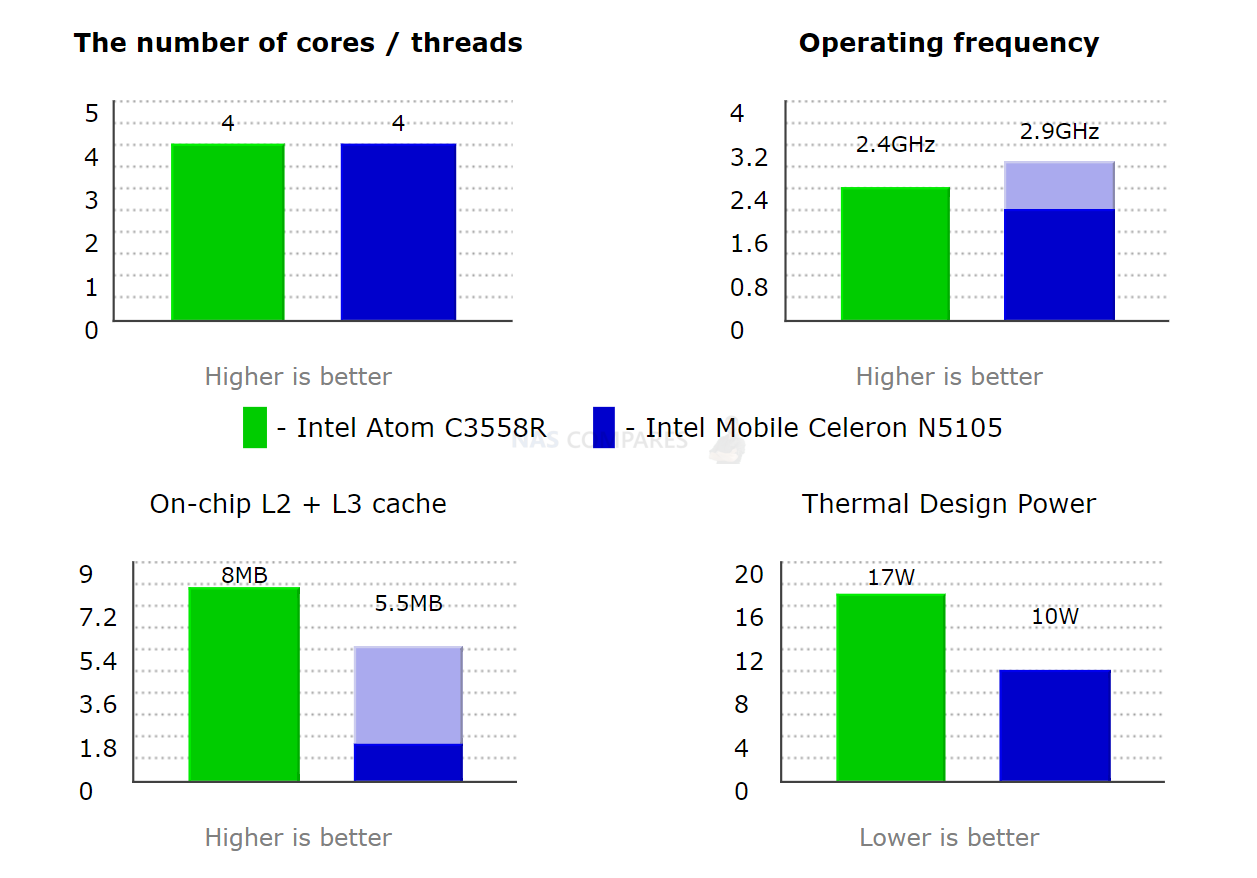
Alongside that CPU, the Terramaster T9-450 NAS also arrives with 8GB of DDR4 Memory (twice the amount of most other systems of this scale and others in the x423 series). Closer inspection of the T9-450 architecture does raise a small question. Firstly, the 8GB of memory the system arrives with is a single 8GB SODIMM module, which is great as this is double what most other brands would include in this storage tier + price point – but it is not ECC. I get the logic behind this, as this is designed to be powerful yet affordable, but there are definitely going to be users who plan on sending through ALOT of data in this system for warm/cold storage, so long term data integrity is going to be paramount! Yes, there is redundancy options in place such as RAID 6 and the syem does support BTRFS, but given the CPU used in the T9-450 DOES support ECC memory, perhaps opting for 4GB of DDR4 ECC memory by default (and then also supporting the use of non-ECC memory by users as a matter of choice) might have been a better middle ground. Also, I am still not completely in love with their slightly stern approach to users opting for 3rd party memory. again, it’s not as black/white as Synology, but still a little more stringent than I would have expected. Overall though, I think most users will see 8GB of memory in a 10GbE ready system like this as a plus overall!
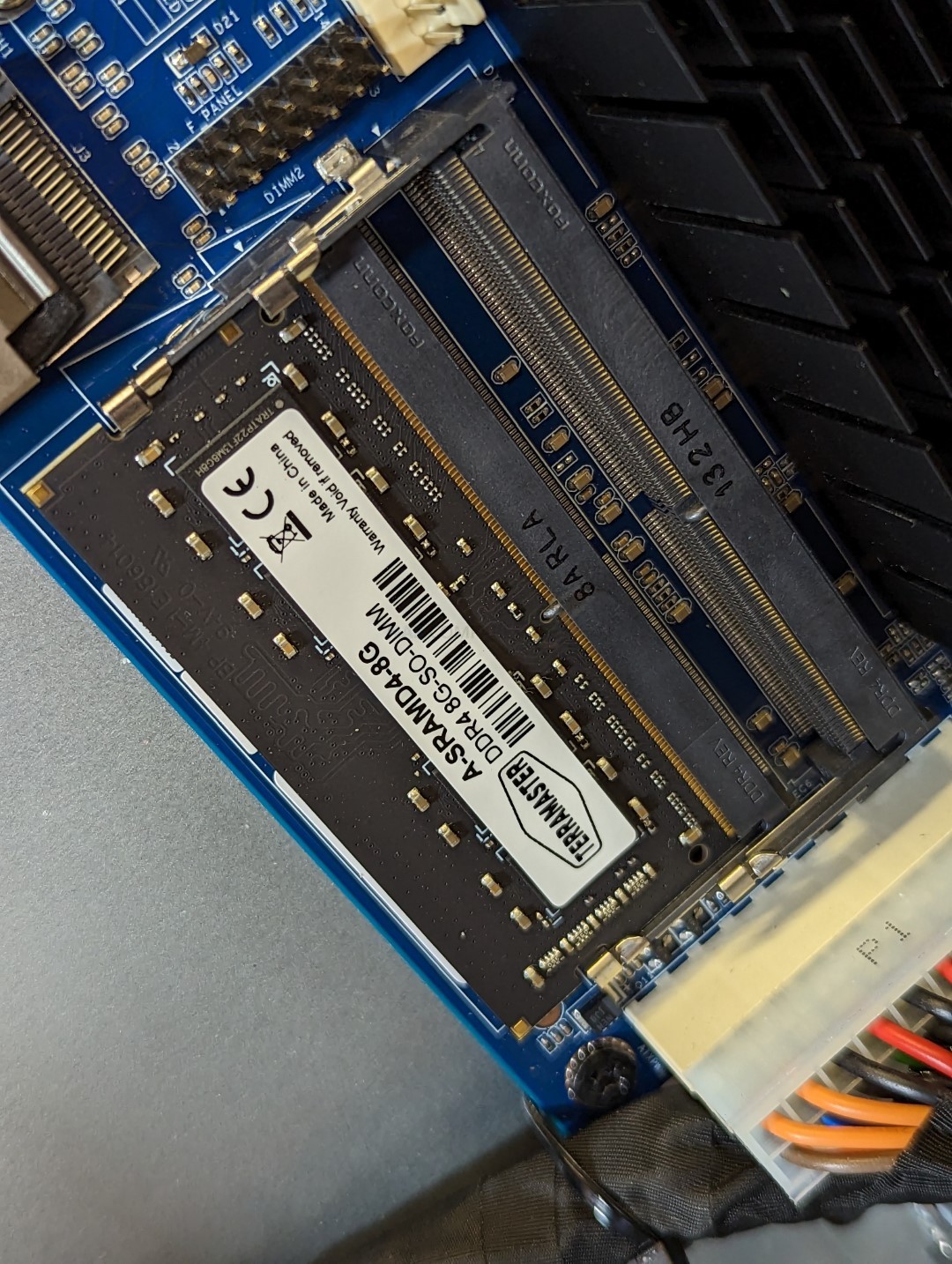
The Terramaster T9-450 also features two M.2 NVMe SSD bay that allows you to install significantly faster SSDs into the system alongside SATA HDDs, meaning that you have another option for your storage. Now, there is good and bad news here regarding this port. On the plus side, it can be used for either caching alongside the larger HDD RAID configuration (to allow read-only caching and improve their performance in key areas) or as its own storage pool. This is something that popular NAS competitor Synology has never implemented to their NVMe bays, despite it being a highly requested feature. On a slight downside, as the Intel CPU inside the Terramaster T9-450 is already being stretched a little thing in it’s architecture, the M.2 NVMe SSD bay are PCIe Gen 3 x2 speed. This means that NVMe SSDs such as the Seagate Ironwolf 510/525 or WD Red SN700 at PCIe Gen 3/4 x4 will be limited down to a maximum 2,000MB/s transfer speeds. This is still something you can incorporate into a solid RAID for improved performance and its better to have them, than not at all though.
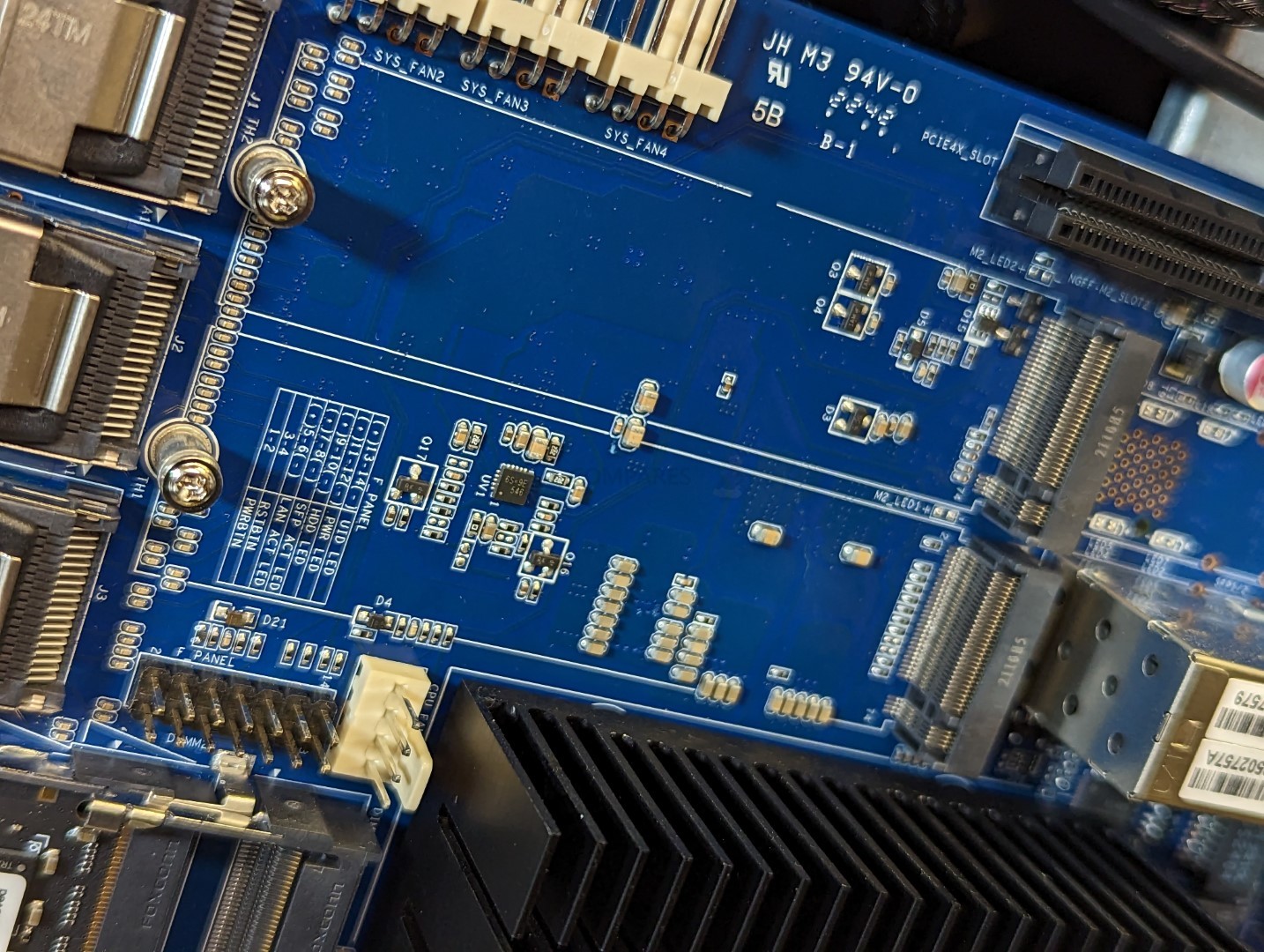
The system also seemingly features an available PCIe 3×4 upgrade slot too (without a guide clip/stopper, meaning the potential for an x8 length card being physically possible. The rear of the T9-450 casing does not feature any kind of backplane/spacing for this PCIe card slot to be evolved into additional external network connectivity, so that is largely off the cards. This hardware detail was picked up AFTER the initial review of the T9-450 was completed and photography was made, so I have yet to test if this slot is current active (and if/what it supports). But as soon as it is, expect it to be updated here in the review!
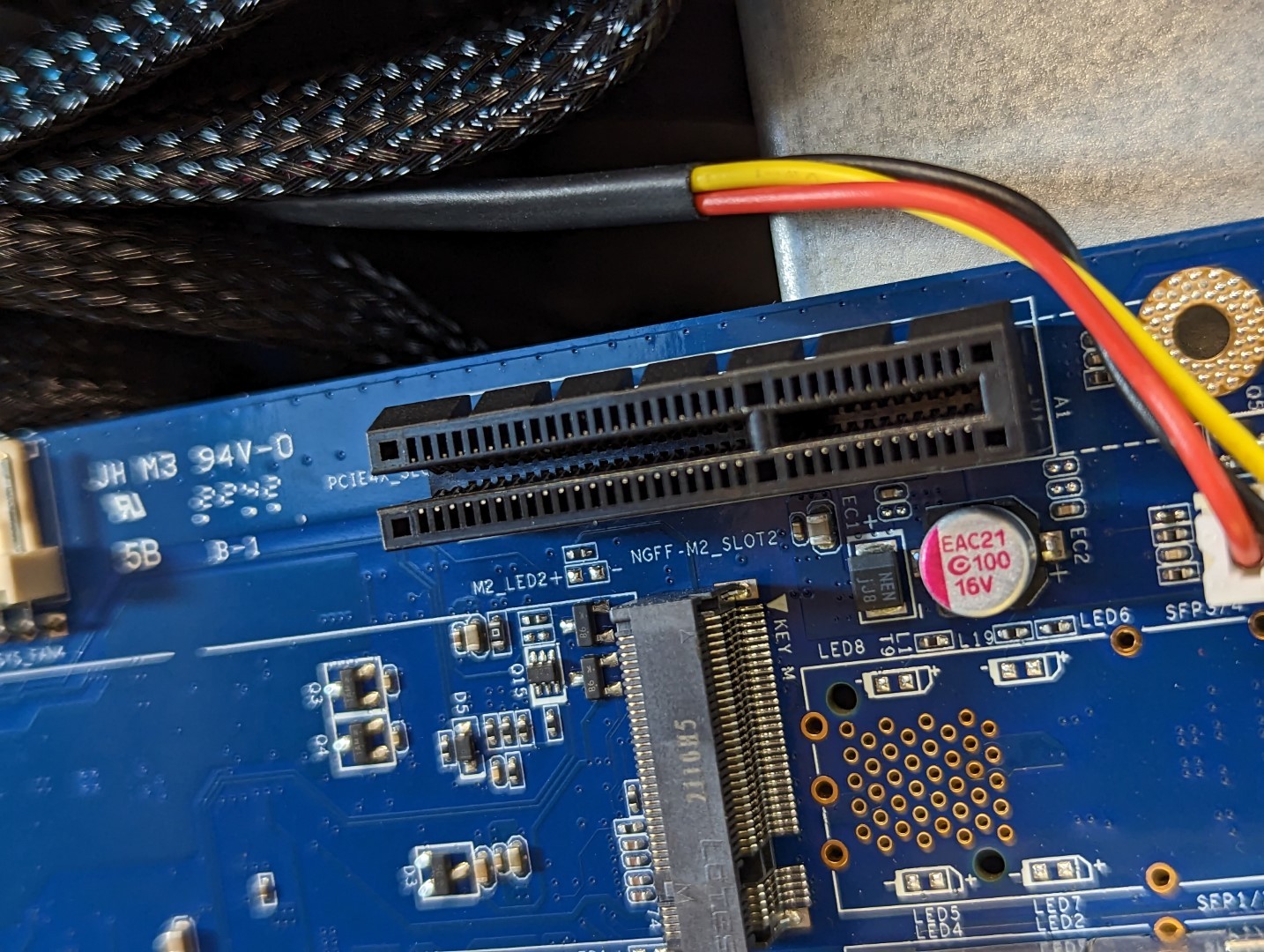
Finally, we have the internal USB Slot that contains a pre-installed drive which contains the TOS 5/5.1 bootloader to initialize the OS of the system. We have already covered in length over on the YouTube channel in multiple video guides (click on each, they will open in a new tab) on how to install server OS’ such as TrueNAS, UnRAID and Proxmox on a Terramaster NAS, which means these system are actually quite useful for users looking for a prebuilt NAS server solution to buy off the shelf but then choose to use their own OpenSource/Paid server software instead! Hosting the OS Installer on an internal USB instead of a pre-installed flash drive (such as found on other brands) is not new and indeed, many popular OS’ actually RUN this way (again, UnRAID is a great example). This USB only hosts the installer, with the NAS needing the actual OS to be installed on an area of the available drive storage.
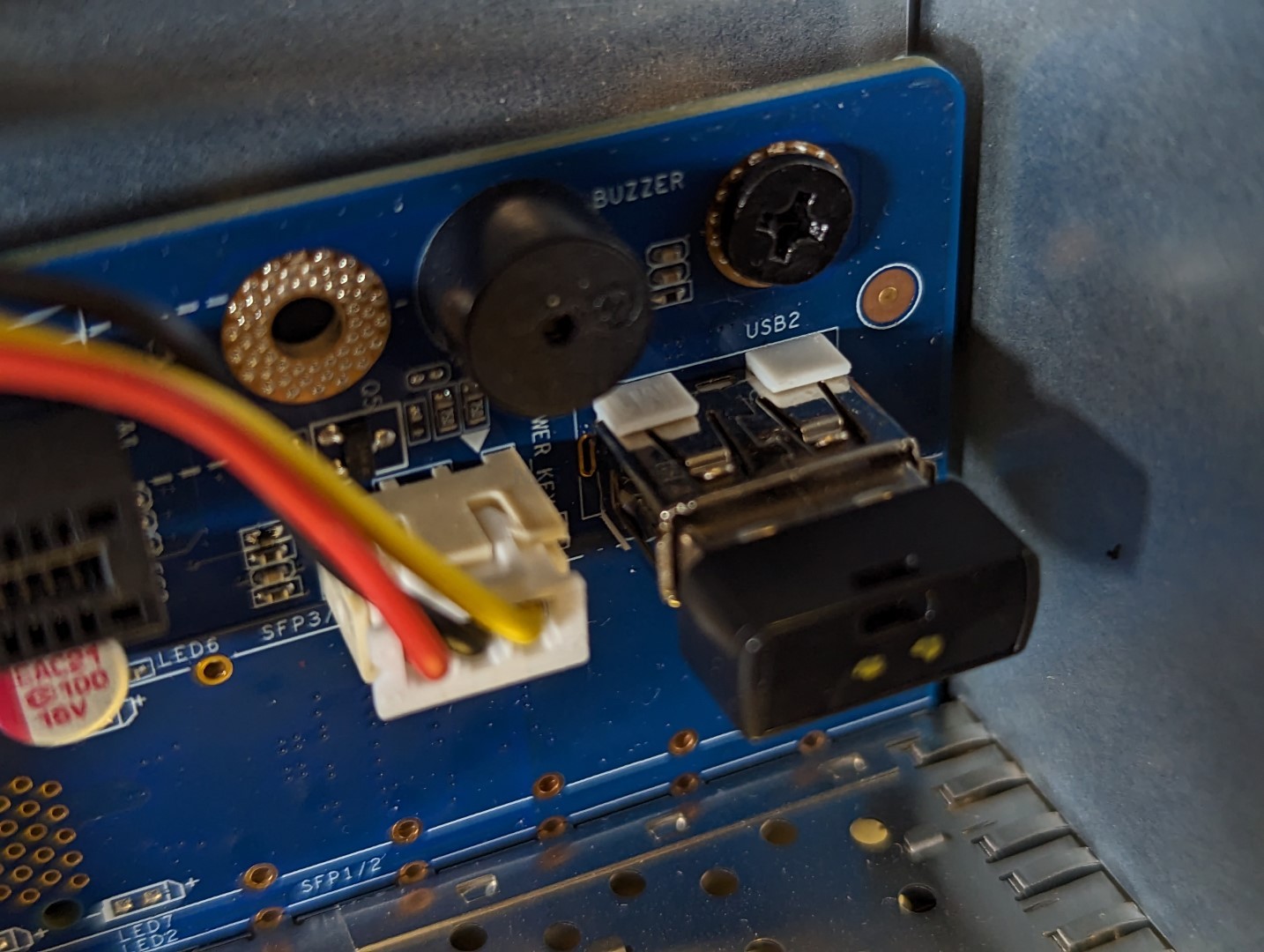
The internal hardware inside the Terramaster T9-450 is still good for the money and certainly gives you a solid base level of hardware to work with to maximize those 10GbE network ports! The means to access and upgrade the system hardware is less conventional than most/all other commercial NAS brands, but once you have jumped these odd hurdles, you have some great kit here to use in conjunction with 1st and 3rd-party applications. One nagging point for me is that the system COULD have used the onboard lanes that they used on the M.2 NVMe bays in a better-leveraged way instead towards a proper and accessible PCIe upgrade slot (ther e is clearly a slot there and it’s kinda overlooked). Then users could have made their own choice between an SSD caching upgrade card OR opting for further network connectivity. Let’s move into the subject of software and TOS on the T9-450.
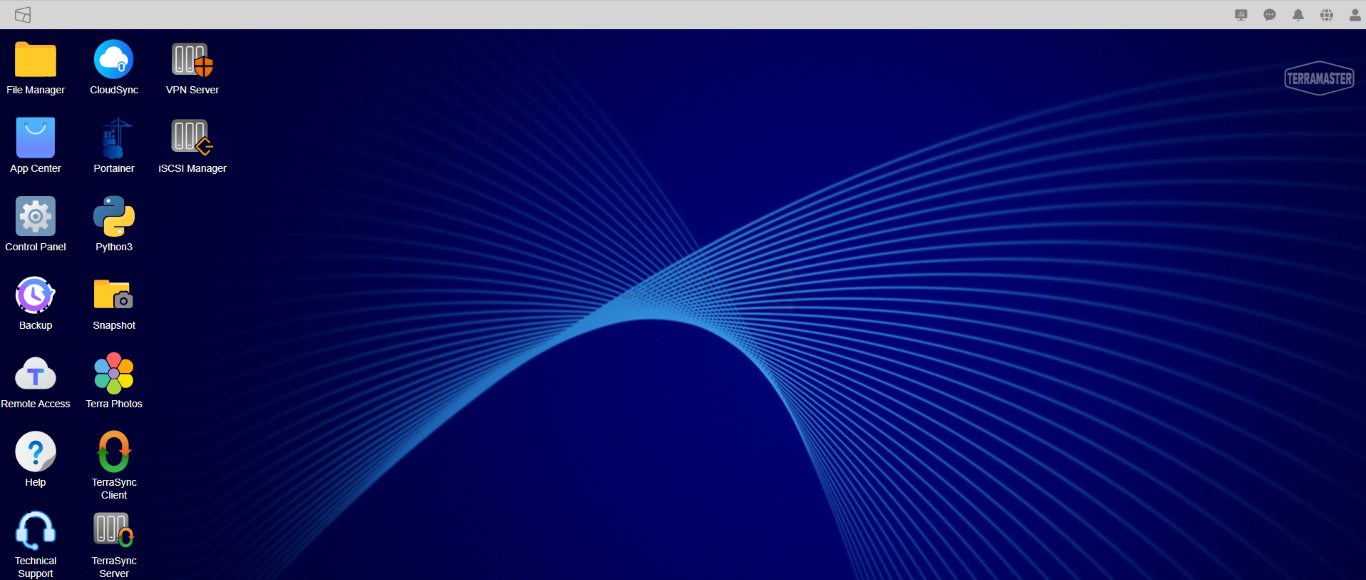
Terramaster T9-450 NAS Review – Software
If you are an existing Terramaster NAS owner, or are someone that has been considering their NAS brand for your private server purchase, then you might have heard that they recently released their latest BIG software update. Upgrading from TOS 4 to TOS 5, this new update brings a huge range of improvements in the GUI, available applications, supported services, security and user controls to their NAS systems. It is important to note that even though TOS 5 is now fully released and in its non-beater version, some applications are still in beta within this software platform and although I will touch on them throughout this review, I will make a point of highlighting when some applications in full release or are still in Beta. These include Terra Photos, Terrasync tools, Centralized Backup, and elements of Terra Search and Surveillance Manager. Although all of these applications are still available in the app center, the experiences I had with them still demonstrate that they are not in their final form and suffered weak resource sharing with the rest of TOS5. Otherwise, all other elements discussed in this review are in their full-release candidate form. Additionally, at the time of writing, TOS5 is not available for ARM processor NAS devices. I made a MASSIVE review of TOS 5 in it’s own dedicated article below, which I recommend you read if you want to know the FULL scope of what TOS 5 can and cannot do:
Click Below to read the FULL Review of TOS 5 for Terramaster NAS
What I liked in TOS 5
- The GUI is considerably clearer and much more vibrant.
- The options and icons in the GUI are much more responsive and clear against other background activities.
- There are considerably more backup and synchronization tools in TOS5.
- There are a vastly improved number of storage configurations and services available at your disposal.
- The mixed drive TRAID Is going to win serious points with ex-synology owners.
- The system includes direct tech support and remote access terminal for official support and difficulties
- The network isolation mode in TOS5 is both unique to the brand and particularly helpful.
- The resource monitor is 10 times better than in previous versions of TOS 5 and genuinely useful.
- The upgrade path between TOS4 and TOS5 is not as smooth as it should be. And will confuse some and concern others.
- Multimedia tools are a little lacking and although there is a general DLNA media server application and the photo app in beta, there is no dedicated video or music tool available.
- The Surveillance tool has kinda gone dark/disappeared!
New Features & Improvements in Existing Services in TOS
In TOS 5, not only have the storage structure and data interaction mode been reconstructed but also, compared with the previous generation, it adds more than 50 features and 600 improvements. The new features meet more business requirements, as well as significantly improve response speed, security, and ease of use.
Browser Access to TOS is Now 3x Times Faster
TOS 5 adopts progressive JavaScript language and a lightweight framework with a faster loading speed. TOS 5 features bidirectional data binding, easier data manipulation, and automatic synchronous response to data changes in the page; UI, data, and structure separation make it easier to change data without the need to modify logic codes. Using progressive JavaScript language, TOS 5 has a more lightweight framework. In addition, through two-way binding of data, the view, data and structure are separated. When the page is operated, it automatically responds to changes in data, which makes the system “lighter” and achieves a faster loading speed.
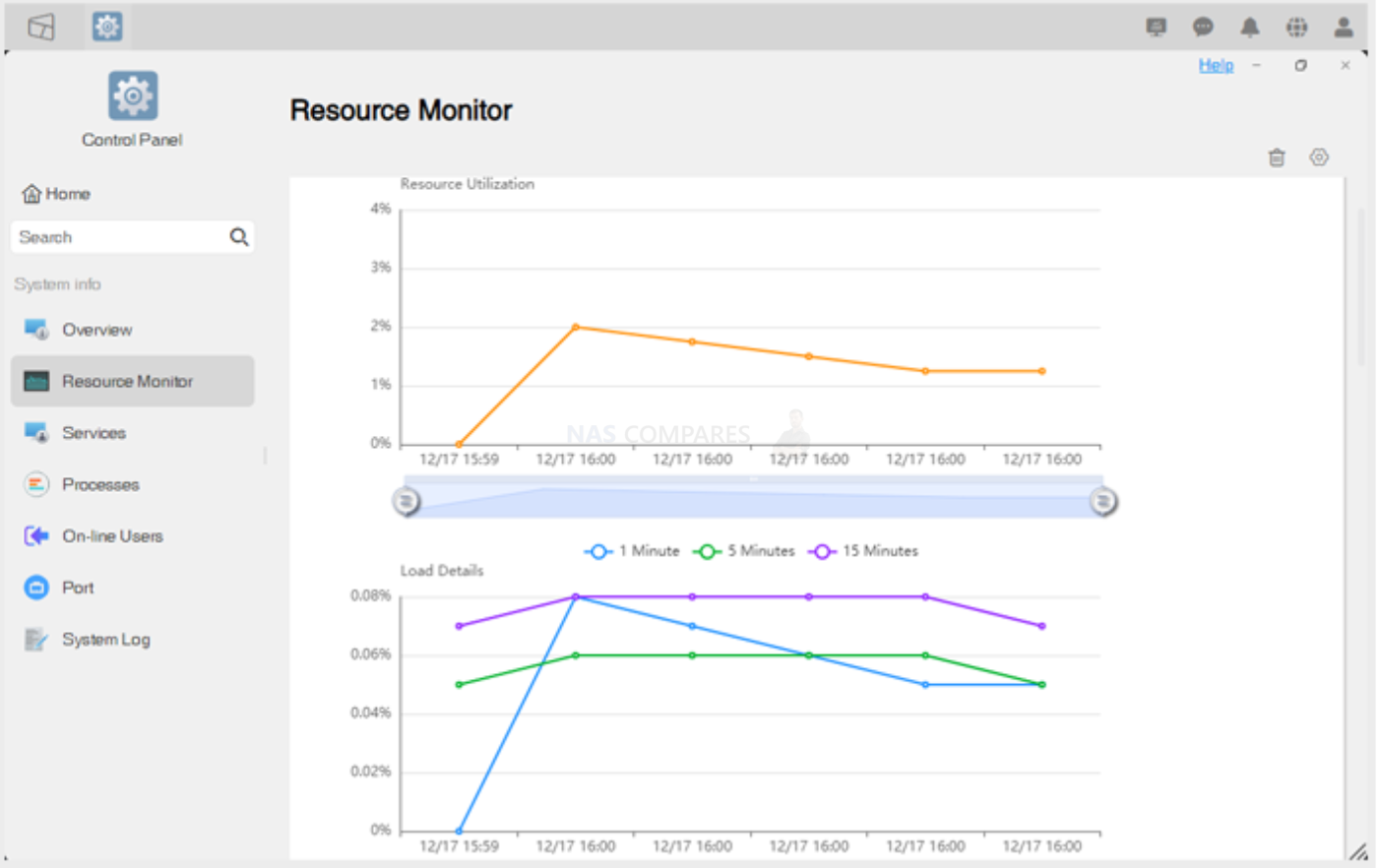
New caching technology avoids network round trips between the server and the database, bypasses the calculation that occupies resources, saves server resources, and improves response time and waiting time, so TOS 5 has the fastest response time in the current TOS family. Compared with the last generation, the TOS 5 response speed has increased by 300%! Use WASM to optimize the calculation method and execute the back-end complex calculations on the front-end, thereby reducing the calculation pressure on the server. In addition, TOS 5 uses the most popular back-end language at the moment, which can support high concurrent requests. Compared with traditional interpreted languages, the compilation speed is faster.
Improved Resource Monitor in TOS 5
The new iconic resource monitor board allows you to grasp the operating status of your TNAS comprehensively and intuitively in real-time; at-a-glance visibility of system load, CPU and memory usage, network traffic, disk I/O, device temperature, storage, processes, online users, listening ports, and system resource occupancy. Historical records of up to 30 days can be easily traced back.
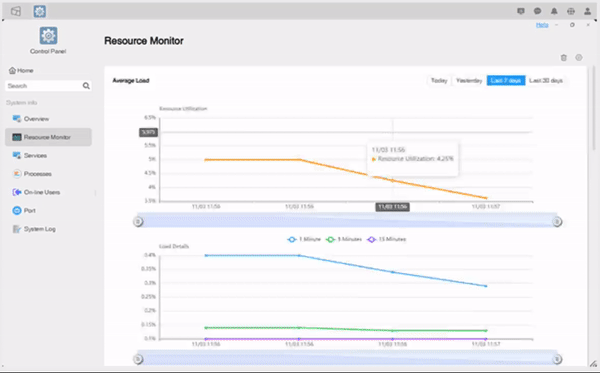
Full One Button System Isolation Mode Available in TOS 5
TerraMaster’s unique security isolation mode completely isolates your TNAS device from the external network through network isolation, digital signature, and file format restriction, providing a safer operating environment and effective protection against virus and ransomware attacks.
Support of the WORM File System in TOS5
Data can be written at one time within the customized protection period and cannot be deleted or modified. This effectively protects your data from malicious damage, deletion, or tampering and provides data protection for up to 70 years; essential for the financial, judicial, medical, and scientific research sectors, as well as other business users.
Improved Storage, Backup & Sync Features in Terramaster TOS 5
TOS 5 features optimized storage architecture to reduce the system space occupation. The file deduplication system, file system compression, TRAID elastic array, and other functions also save you up to 40% of storage space
Single Portal Folder Level Backup for Home and SMB Users
Reduce complexity and embrace simplicity. All backup needs can be completed through a single portal, providing one-stop backup solutions including Central Backup, TerraSync, Duple Backup, Snapshot, USB Copy, CloudSync, and other comprehensive backup tools. This meets your clients’ disaster recovery and restoration requirements, as well as backup policies and destinations.
Business Focused ProActive Backups for Larger Business
To improve management efficiency, medium and larger-sized businesses need a centralized and active backup solution for multiple users, PCs, and servers. Centralized Backup is a business-oriented backup solution that supports backup and restoration for multiple device types. You can centrally backup data of dozens or even hundreds of PCs, servers, or virtual machines with only one TNAS.
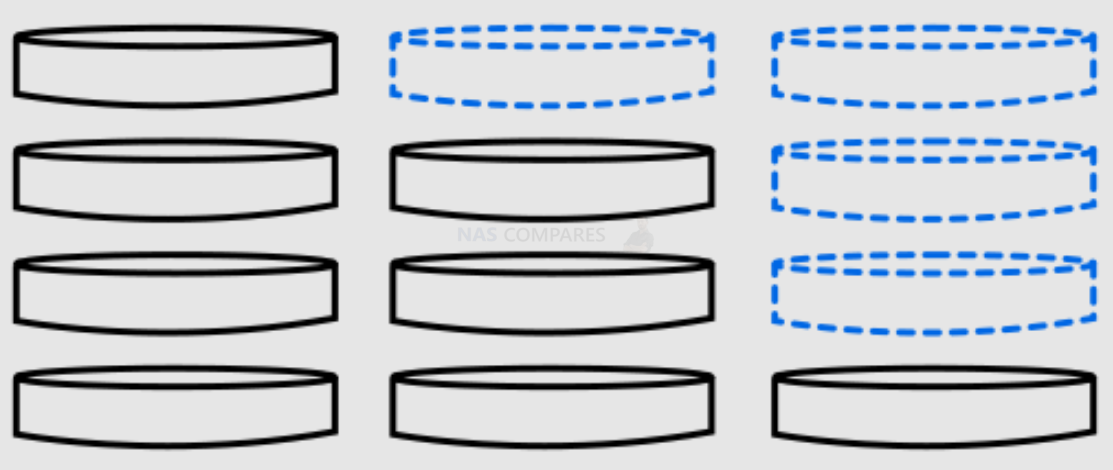
New Flexible RAID Support in TRAID in TOS 5
By optimizing the traditional RAID mode, TerraMaster RAID (TRAID) gives you flexible disk array configuration, flexible online migration, capacity expansion, and redundancy policies. As well as improving disk space utilization, it also provides solutions and security protection for storage space changes caused by new business requirements. Much like Synology Hybrid RAID (SHR) in that you can mix drive capacities for improved storage after the RAID redundancy calculation. I reached out to Terramaster directly on this and they confirm that this function is supported in TOS 5.
Multiple Client Sync with TerraSync in TOS 5
TerraSync, a TerraMaster self-developed synchronization tool, realizes data synchronization between multiple users and multiple devices. It efficiently implements data sharing among branch offices and data synchronization between individuals on multiple devices and platforms, which assists employees in collaborative work and improves work efficiency.
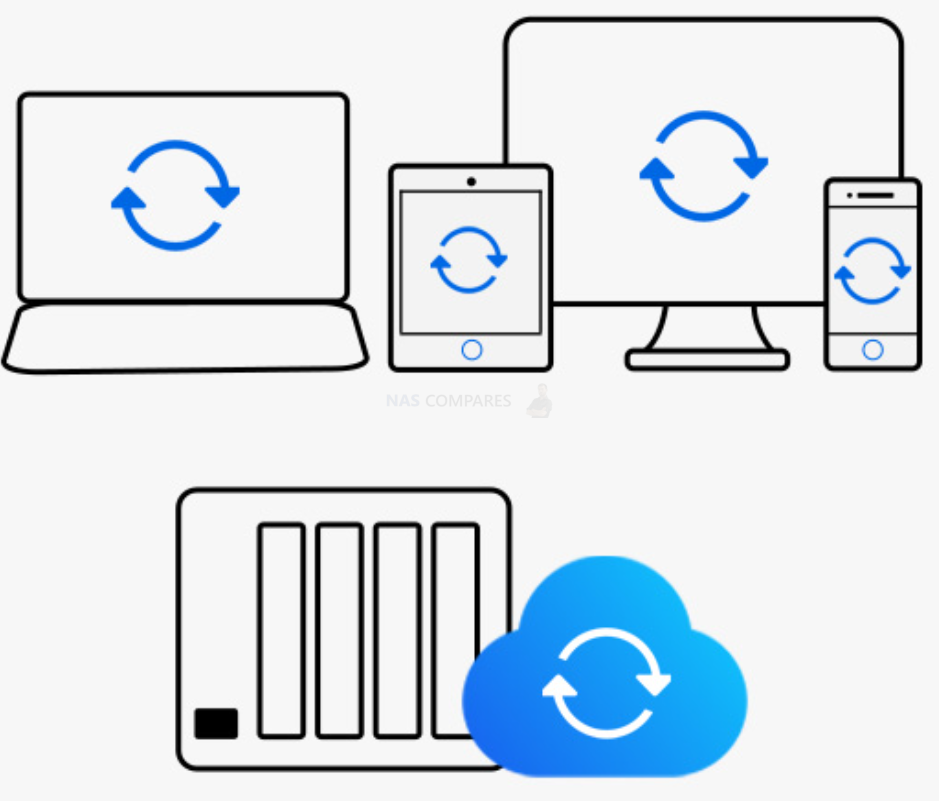
New CloudSync Application for Bare Metal-to-Cloud Live Sync in TOS 5
The new CloudSync app integrates multiple cloud drives and syncs them into one application, including Google Drive, One Drive, Amazon S3, Backblaze, Box, Dropbox, Koofr, OpenDrive, pCloud, Yandex disk, and Aliyun. This allows users to centralize the management of multiple synchronization tasks and add a variety of cloud disk synchronization options including Aliyun and Rackspace. A more flexible, stable, and efficient solution for data synchronization between your TNAS and cloud drives is facilitated by your choice of customized synchronization strategies, such as traffic control, scheduled tasks, and encryption.
CCTV Surveillance in Terramaster TOS 5
TNAS is an ideal video recording storage device. The new Surveillance Manager makes full use of TNAS storage resources to realize camera management, real-time monitoring, video storage, playback, query, event and activity monitoring and recording, providing you with economic and flexible video monitoring management tools to safeguard your personal and property safety.
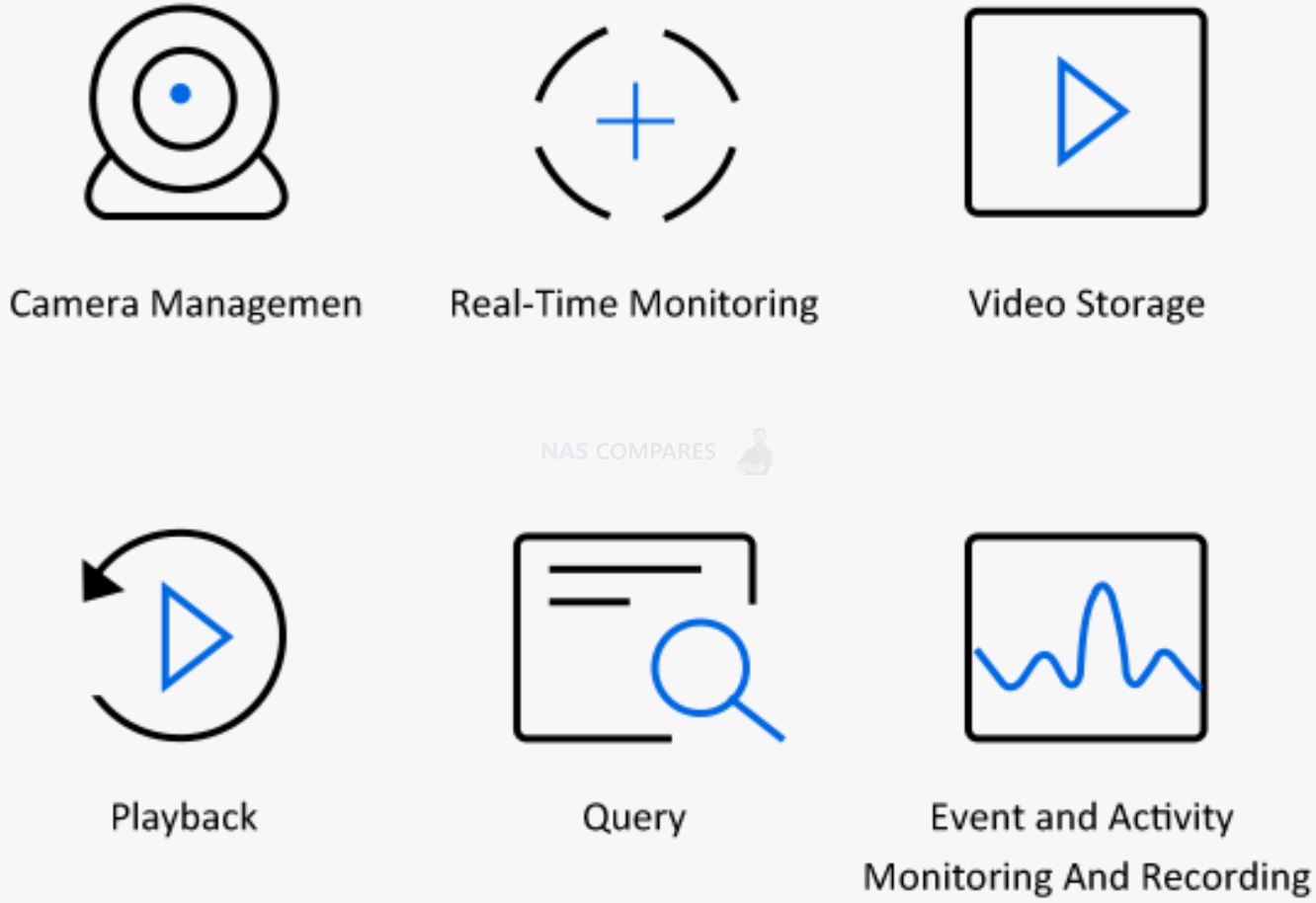
AI Photo Recognition Now Available in TOS 5 with Terra Photo
Terra Photos is TerraMaster’s brand-new AI photo management application that provides smart solutions for your photo management and sharing; it uses intelligent AI algorithms to identify and classify faces, pets, locations, and other objects in your photos.

Docker Added to Existing Container Tools in TOS 5
Combined with docker-compose and portainer, the new Docker Manager features an optimized operation interface, with multiple new features which provide visual management that meets all your requirements for container customization and flexible configuration.
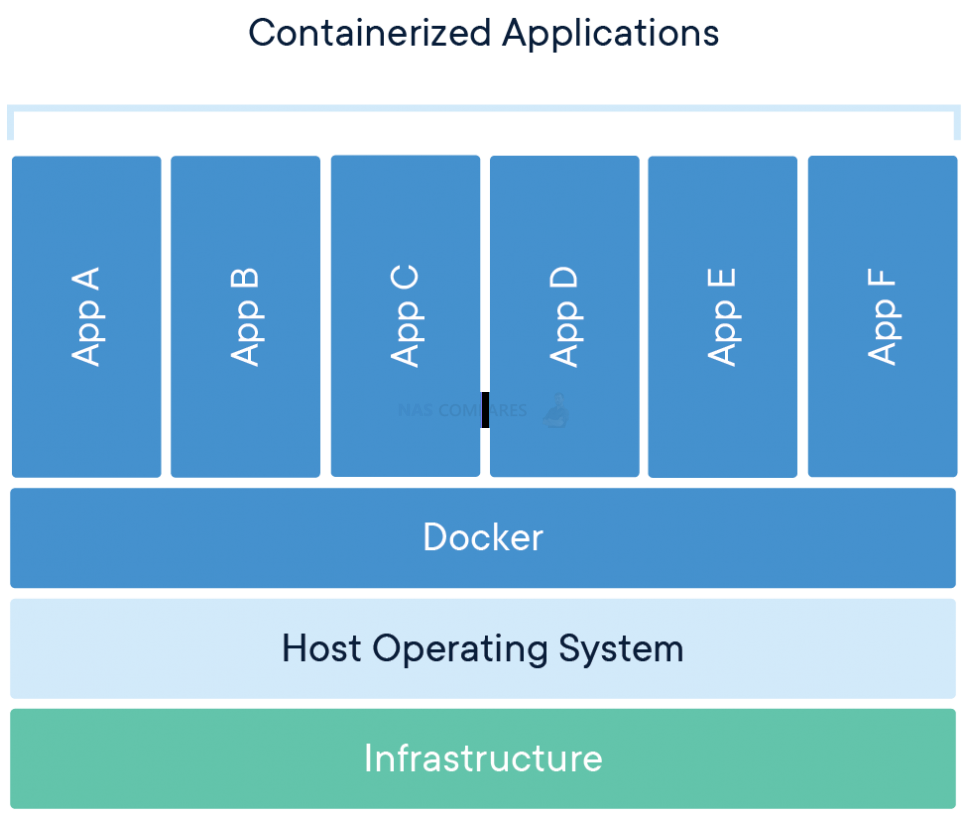
New Update to Terramaster’s Mobile App, TNAS Mobile 5
To adapt to TOS 5, TNAS mobile has also ushered in a comprehensive update, TNAS mobile 5. Featuring an optimized user interface and interaction, it has also added mobile phone backup, photo management, personal folders, team folders, data safebox, TerraSync, remote administrator, and other functions, which provide more convenience for remote access, mobile office, and remote management of your TNAS. Once again, I need to highlight that the T6-423 NAS needs to be viewed with its price tag always in mind. With software and hardware that is available on other NAS brand devices, it is easy to imagine that this device is a much, more affordable alternative to QNAP or Synology NAS. However, you should always remember that this device is still aimed at those looking for a first dip into NAS and if should be compared with WD NAS and D-Link when making your choice of NAS. it is DEFINITELY better than those and arrives at a better price, but it may still be a year or more before the Terramaster TOS Software platform can compete with DSM and QTS. That said, the Beta is really showing that TOS is going to evolve even further and for more information about the TerraMaster TOS operating System, I recommend visiting my software review here from a couple of years ago.
Key Software and NAS tasks that are supported are:
- RAID 0, 1, 5, 6, 10, JBOD – as well as TRAID, the Flexible RAID configuration
- Apple Time Machine Backup
- Cloud Migration and Synchronization
- NAS to NAS Rsync Support
- Plex Media Server
- Docker
- Mail Server
- Web Server
- DLNA Media Server
- WordPress Server
- Download Server
- Snapshot Support
With a good range of applications to choose from, as well as the support of modern NAS applications in the mix, the TerraMaster T9-450 does give you a good base with which to start your NAS journey, though it may feel a little streamlined for those with greater NAS experience. It is also worth mentioning that TOS 5.1 is currently available in Beta (as of Jan 2023 to now) and includes numerous improvements that include:
1. Upgraded kernel – The TOS 5.1 kernel has been updated from 4.19 to 5.15. Compared to the previous generation kernel, TOS 5.1 Beta optimized EXT4/Btrfs/NTFs file systems and SMB3 file server, used ext4/f2fs/ubifs file system encryption in the encryption API, enabled Apple M1 SoC functionality under Linux and added USB 4 interface support, which greatly improved the performance and security of file system.
2. 4K hardware decoding – The new hardware decoding driver for Intel Jasper Lake GPU is added, which will significantly improve 4K video hardware decoding capability for TerraMaster NAS.
3. Storage pool expansion via USB – By connecting TerraMaster USB disk array, users can easily expand the storage space of the storage pool for TNAS. It supports TRAID/RAID 0/RAID 1/RAID 5/RAID 6 array mode and provide 10Gb storage bandwidth. Compared with eSATA or mini SAS expansion enclosures, TerraMaster USB expansion enclosures are more economical and more convenient.
4. Hyper Cache – TerraMaster Hyper Cache is TerraMaster unique SSD cache acceleration tool. Hyper Cache can provide up to 3 cache modes to choose from to suit different usage needs, and can also create disk arrays for SSDs to increase cache speed and security. Such configuration delivers high-speed storage that’s ideal for video editing.
5. Categorized notifications – TOS 5.1 Beta optimizes system messages and divides message notifications into four levels: information, success, error, and warning. Each level of messages is marked with a more eye-catching symbol of different colors. User can always keep track of any abnormalities in the system and ensure the security of the system and data.
6. USB storage management – TOS 5.1 fully optimizes the mounting of USB partitions. The system will record the path of the last mounted USB partition. When re-mounting next time, the original path will be allocated first to provide more storage space for the use and backup of USB.
7. Optimized Docker Manager – TerraMaster launches updated version of Docker Manager and updates the Docker engine to 20.10.17 version. The optimized interface brings it in line with users’ aesthetics and usage habits. Container deployment is more flexible and TerraMaster NAS utilization is optimized.
8. Better AI computing performance – TOS 5.1 replaced the more powerful Intel OpenVINO AI computing engine, combined with the new Terra Photos application, the intelligent photo recognition efficiency increased by 30%. Terra Photo is designed for home users and photography enthusiasts to manage photo storage, share and access photos from anywhere.
We will likely see TODS 5.1 roll out as a full release candidate and full availability in Q2 of 2023.
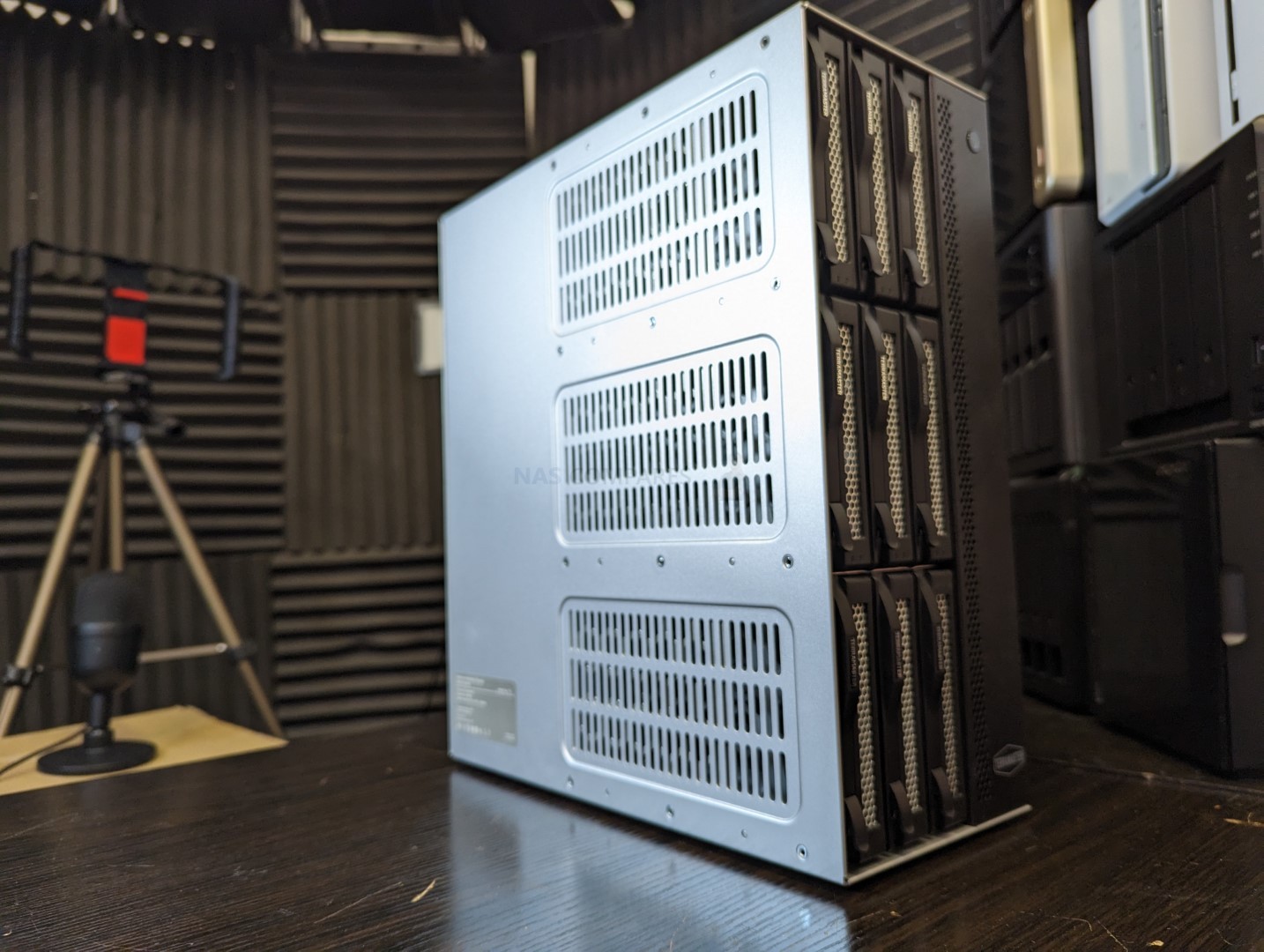
Terramaster T9-450 NAS Review – Conclusion
Terramaster has really changed the playing field with the T9-450 NAS. I was already a big fan of their latest generation of 6-Bay, 9-Bay and 12-Bay desktop chassis – providing a pretty substantial amount of storage in a tower design that borrows ventilation methodology traditionally found in rackmounts, but the T9-450 takes this logic and doubles down on it hard. The dual 10GbE on the system means that, despite it’s comparatively modest price point (when comparing against similar scale solutions from Synology and QNAP) you genuinely have a solution with the potential to allow you to enjoy every single MB/s or GB/s of your RAID externally. This is further bolstered with additional 2.5GbE ports, m.2 NVMe bays, uncomplicated support of HDDs/SSDs and just generally a very sensible system that shows how much Terramaster has matured as a brand. The TOS software is still not quite up there with Synology’s DSM or QNAP’s QTS in terms of ease of use and AAA+ features, but it is definitely a great entry point OS that has tighted it’s security since the brand was targetted by a ransomware group (along with other brands, they were affected by Deadbolt attacks) – it certainly lacks some of the background optimization of it’s competitors, but then this is reflected in the budget of the system too. The internal PCIe slot that has been largely ignored is a bit of a missed opportunity and I am not a big fan of how they have addressed memory compatibility, but overall it is very, very tough to criticise the T9-450 NAS when you factor in the value of the package here. Factor in that you can very easily swap out the OS for many others, and it largely silences alot of the negatives here too. Overall, the T9-450 could potentially be the best NAS that Terramster has ever released and if they continue to address later releases with the same level of hardware value, this could definitely give the bigger names in the industry something of a headache down the road. I highly recommend this system for its value and performance potential!
| PROS of the Terramaster T9-450 | CONS of the Terramaster T9-450 |
|
|
Click the link below to take you to your local Amazon store and where to buy the terramaster T9-450 NAS.
📧 SUBSCRIBE TO OUR NEWSLETTER 🔔 This description contains links to Amazon. These links will take you to some of the products mentioned in today's content. As an Amazon Associate, I earn from qualifying purchases. Visit the NASCompares Deal Finder to find the best place to buy this device in your region, based on Service, Support and Reputation - Just Search for your NAS Drive in the Box Below
🔒 Join Inner Circle
Get an alert every time something gets added to this specific article!
Need Advice on Data Storage from an Expert?
Finally, for free advice about your setup, just leave a message in the comments below here at NASCompares.com and we will get back to you.
 Need Help?
Where possible (and where appropriate) please provide as much information about your requirements, as then I can arrange the best answer and solution to your needs. Do not worry about your e-mail address being required, it will NOT be used in a mailing list and will NOT be used in any way other than to respond to your enquiry.
Need Help?
Where possible (and where appropriate) please provide as much information about your requirements, as then I can arrange the best answer and solution to your needs. Do not worry about your e-mail address being required, it will NOT be used in a mailing list and will NOT be used in any way other than to respond to your enquiry.
TRY CHAT
Terms and Conditions


Do MORE with Your M.2 Slots - GREAT M.2 Adapters!
5 Top Tips for Content Creators Buying a NAS
Terramaster F4 SSD NAS - Should You Buy? (Short Review)
Minisforum N5 Pro NAS Review - Did Minisforum just WIN at NAS?
What Can You ACTUALLY DO with HDMI on Your NAS?
Best NAS for under $499
Access content via Patreon or KO-FI



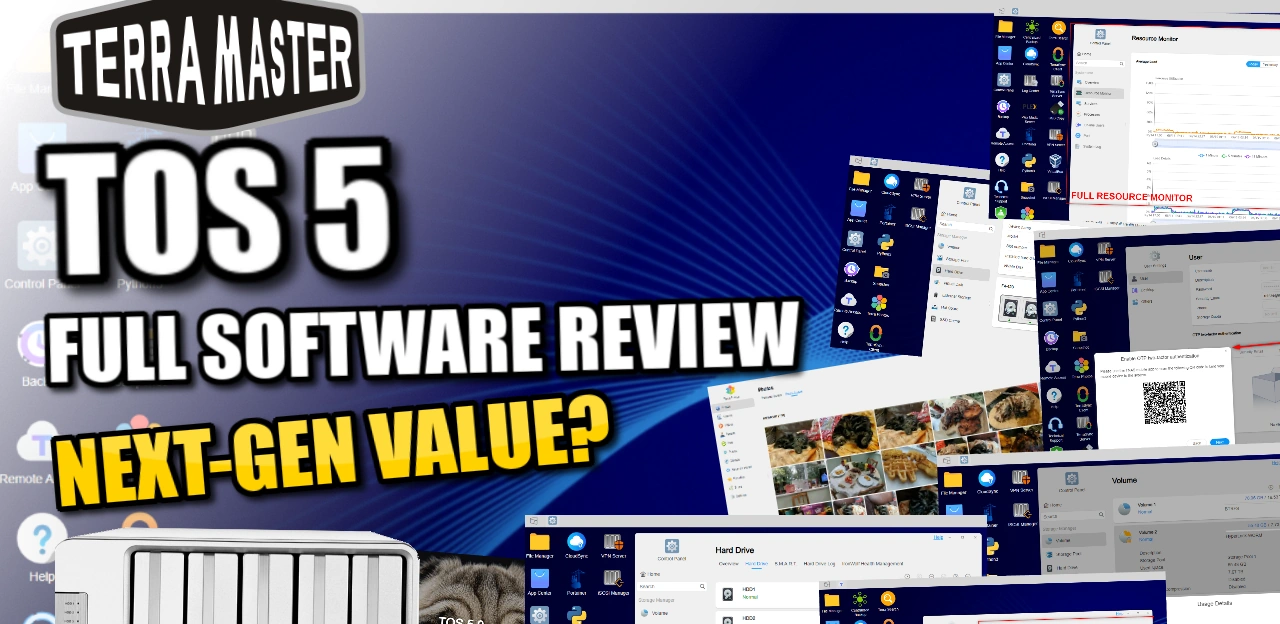
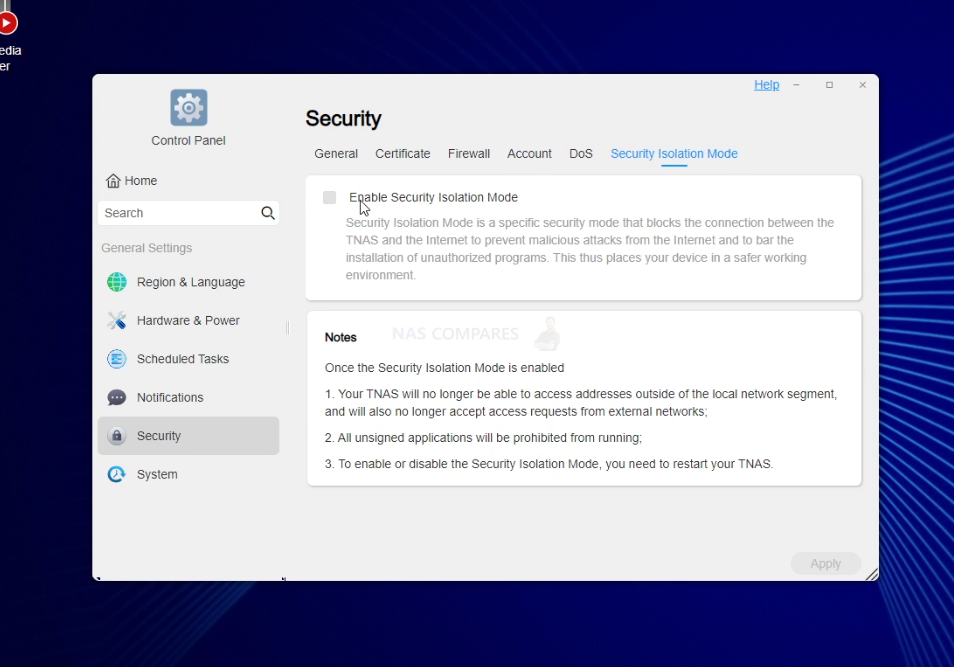




I can’t get it to boot without blacklisting i915
REPLY ON YOUTUBE
For those attempting this now, I had a GUID error when using the UNRAID usb creation tool with the usb stick he recommends. If possible, use a 2.0 usb stick instead of 3.0 If you already have the 3.0 stick like me though, keep reading. I tried to do it the manual way, but when running the “make_bootable” command as administrator, I got an error that it couldn’t find the “syslinux.exe” file.
The solution was actually to download one version older of the Unraid server software (version 7.0.0). After extracting, you want to make sure all of the files are on the outside of the unRAIDserver-7.x.x folder. That way, when you open your flash drive folder, you immediately see all of the files instead of that folder first (delete the empty folder after). Afterwards, running the “make_bootable” command should work.
REPLY ON YOUTUBE
Doing this today, would I download the latest Proxmox? I’m using the F2-423. Would I do something different?
REPLY ON YOUTUBE
i liked the way you explained stuff 😀
REPLY ON YOUTUBE
This setup is rather nuts than useful!
First: Dont install the OS on freaking 4TB, those drives are for your Data. What a huge waste
second: You can use every port for booting, but its smart to keep the front USB free for Keyboard/Mouse or a USB-Backup drive etc.
third: Use the USB inside as OS. You have at least 5yrs before a pendrive USB wears off. You can also use a usb-to-sata and use a sata drive. (In the Terramaster-Case use a 99degree Angle USB-Cable as there is tiny space)
REPLY ON YOUTUBE
has there been a reliable way to get unraid to work of the terramastet f6-424 max?
REPLY ON YOUTUBE
This is really a shitty video. Did exactly what described. Terramaster F2-423. Trunas installed on 32gb bootdisk with rufus. Tried diverse bootmethods.. Booting from nvme. Boot tos disabled in bios. But the system never booted in TNAS. It stucks in de TNAS menu. Reinstalled the original TOS usb disk. After changing de bootdisk to BIOS, the system boots into the shell.
REPLY ON YOUTUBE
Terranas boots up in GRUB and not TRUENAS. Removed de usb stick. Changed bootorder to NVMSE2. But keeps booting in Grub and keeps saying Tos boot USB storage not found. This is not as expected. Really disappointing.
REPLY ON YOUTUBE
Thanks for sharing this video, quite insightful!
REPLY ON YOUTUBE
Hi – thanks for the great video, it helped me decide to get this F8 SSD Plus. People are mentioning the slow RAID rebuild speed: perhaps it a new setting, but in the TOS 6.0 interface under Storage Pool settings (gear icon top right), you can set a custom speed. I set the minimum to 512MB/sec and the max to 800MB/sec, and after logging in via SSH and running “watch cat /proc/mdstat” was able to see this running around 800MB/sec! Not sure where else to share this so please spread the word and save people hours ????
REPLY ON YOUTUBE
Any other usbs you can recommend? That particular one doesnt have a GUID, so it cant register an unraid license
REPLY ON YOUTUBE
Can I do the same for TrueNAS Scale? Do you have a video for it? Thanks
REPLY ON YOUTUBE
Paying attention to the label on the bottom is much easier for correct orientation. See where it is before disassembly.
REPLY ON YOUTUBE
Thank you for the simulation of wrong side install, we know you are one of the best…
REPLY ON YOUTUBE
So basically a Linux OS lol
REPLY ON YOUTUBE
DO NOTUSE the recommended USD drive!!!!! The latest Unraid USB creator will not use it, says it’s incompatible sees it as a 0mb drive on Windows and Mac despite the OSs seeing the full size of the drive and are able to use it.
REPLY ON YOUTUBE
perfect, this way on a uGreen 8bay case …. (because 2x 10GB)
REPLY ON YOUTUBE
Please don’t spin the mouse pointer like that!!!!!!!!!!!!!!!!!!!!!!!!!!!!
REPLY ON YOUTUBE
there is one think i dont fully understand. Why using that internal usb? When i look up how unraid works i see that you get an boot window that lets you chose from where to boot. Can’t i just stick it in one of the outer usb drives?
REPLY ON YOUTUBE
Does TOS5 support NTFS in terms of external USB 14TB HDD connection?
REPLY ON YOUTUBE
Thanks for this tutorial, it helped me get UNRAID set up on my Terramaster. The USB stick (USB 3.1) showed the same error so I had a similar form factor USB2 stick which was picked up by the UNRAID creation tool. So, if anyone attempts this they might want to factor that in, if they want to use the UNRAID tool. Another point is that Apple Mac Keyboards don’t work so mac users will want to purchase a cheap windows keyboard if they don’t have one already (amazon has them for ten bucks which will do the trick).
REPLY ON YOUTUBE
I have a F5-221. Unfortunately it does not have a nvme slot. If I place a SATA in one of the bays can I use that to install Proxnox on it? Will it boot from it?
REPLY ON YOUTUBE
Hello !
Lately I’ve been carefully following your channel and blog about NAS systems.
At this time, the question arose of choosing between Synology DS423+ or Terramaster F4-423 NAS.
Before your reviews, I checked a lot of information about Terramaster and just like you, I came to the conclusion that Terramaster is much better in hardware than Synology.
Until the moment when the need arose to use something more compact and less energy-consuming than a PC with True Nas installed, I did not explore the market for compact NAS systems.
With Terramaster, new horizons and opportunities have opened up.
Great video review!
Still, I discovered one point in the video: it is not necessary to insert the installation/bootable USB flash drive from TrueNAS inside the Terramaster.
We only need it at the stage of system installation. Upon completion of the installation, it is advisable to remove the USB flash drive and put it aside so as not to occupy the USB ports and not create confusion in the boot devices.
TrueNAS can install the system on a separate disk or soft raid (if you select 2 identical disks during installation – for example, 2 SSDs)
Therefore, keeping the TrueNAS installation flash drive in the device simply does not make sense.
I will also say that if you install the system on a disk, it can no longer be used as part of a RAID array – RAID1 mirror, for example – this is at least what I know from personal experience.
To avoid such problems and inappropriate use of the disk (of course, you can separate the partition with the system and use the free space, but RAID will still not be available for creation), you need to install TrueNas on a separate physical disk – an SSD, for example, or better yet, 2 disks in software RAID mirror.
That way, if the system drive fails, our data in the storage pool will not be affected.
This still makes sense for replacing disks – the system remains the same as it was, but we only change the disks and create an array from them. All settings will be saved.
Perhaps I missed something or I don’t know from either side the whole TrueNas mechanism, but the general concept is this: the disk is separate for the system and the disks for the data pool are separate.
Thanks for the review! Good luck!
REPLY ON YOUTUBE
Surely 8gb Ram wouldn’t be enough for unraid is 8gb ram the max for terramaster ?
REPLY ON YOUTUBE
I lolled so hard when he said… “I have had it installed the wrong way around in the past” then tries to install it during 25 seconds, realizing it is the wrong way around, puts up a weird face, then does it the right way and then forgets to edit that part out. 🙂
Superb video though!
REPLY ON YOUTUBE
can the D4-300 model work on unraid? Thanks!
REPLY ON YOUTUBE
What is the reason to replace Terramaster’s OS with TrueNas? Does TrueNas provide better features? Is there any comparison?
REPLY ON YOUTUBE
Can you do this with the T6-423?
REPLY ON YOUTUBE
hope you don’t want to encrypt your zfs volumes, performance is so bad on f4-423 🙁
REPLY ON YOUTUBE
Lots of regular booming or banging. Are you bashing the microphone on a regular basis? ????
REPLY ON YOUTUBE
Would you recommend that you install Unraid to a NMVe drive if you plan licence Unraid and use it full time?
REPLY ON YOUTUBE
I’m running this on a F2-423 and I completed the hardware process. When I did the bootup however, I got a message ‘grub_fshelp_find_file_lookup’ not found…any idea what I did wrong?
REPLY ON YOUTUBE
Would it not be advantageous to use the Internal USB socket to install TrueNAS on? Would be a sweet way to free up the NVMe slot for maybe a cache.
REPLY ON YOUTUBE
Got a F4-423 for only 400€ on prime day, cant wait to set it up, it sounds like a holy grail for plex by price/performance/energy consumption
REPLY ON YOUTUBE
Will one of the more powerful noctua high rpm fans fit in here? Is the fan accessible for replacement anyway? I’d love to go with something off the shelf that’s power efficient, but I don’t see how the fan will actually keep up with that many hdds in such a tight space.
REPLY ON YOUTUBE
Wow, that sounds total surveillance by terramaster. That is a double no, no. So terramaster is only an option with any other NAS software. Sad.
REPLY ON YOUTUBE
Is plex performance better?
REPLY ON YOUTUBE
I’m ready for the next vide on the set up of Unraid! Cheers sir
REPLY ON YOUTUBE
I was ready to buy one of these but really want dual drive redundancy with TRAID (like SHR2 on Synology). Seems like these large bay and well priced units would be a natural fit. Hopefully they are working on it, I see the occasional vague reference to “TRAID2” in their forums but no further than that.
It is strange they didn’t exactly copy Synology idea.
If the USB was used for installation only, what’s the purpose of keeping that inside???
REPLY ON YOUTUBE
I am looking at getting the F4-423 and x4 16TB in one go and want to run TRUNAS rather than the original OS from the start. What size of nvme would you recommend for the terramaster running for TRUNAS? I am thinking of WD Red SN700 1TB drives or Intel Optane nvme H10 for durability, one for OS and one for cache or would you recommend a different NVME config or brands? Later i think i would like to setup a second identical system as a second tier of backup, but the debit card can only take so much wear at one time after all.
REPLY ON YOUTUBE
14:00 I put a little label inside the zip-lock bag along with the date it was removed, and then tape it somewhere inside the case. Just sayin’…
REPLY ON YOUTUBE
Is this a better idea than building a DIY server? What are the pros and cons. That would be a good video… but also a fantastic comment reply.
REPLY ON YOUTUBE
Hi Ive done this with my terramaster and it wont boot from the USB without going into the bios and selecting it to boot any help with this would be great
REPLY ON YOUTUBE
Ventoy FTW !
REPLY ON YOUTUBE
Installing Proxmox to run on this Terramaster is a TERRIBLE Idea due to the LOW capability Celeron Processor. CPU matters MORE than massive storage. CPU capability is BY FAR the most important spec of ANY virtualization platform. As you probably know, this is NOT the preferred way to use a NAS with Virtualization. I understand your idea, but didn’t hear you convey this is NOT the best method. However it is equally bad or even better than the mfgr. provided docker solutions.
REPLY ON YOUTUBE
The F2-423 with 32 GB ram is an excellent Proxmox host. Same for the F4-423. I’ve got one of each in a 4 node cluster, and they have been pretty solid for 6 months.
REPLY ON YOUTUBE
Thank you for this incredibly information packed summary. I will be setting up my first NAS (Terramaster F2-422) next weekend, when the drives arrive. I consider myself to have a good grasp of general computing and network functions and processes. Having said that, due to the sheer speed at which this video tries to cover every conceivable part of the software, I’m going to have to watch it several times. Also for a beginner video, the assumed knowledge of acronyms and other jargon is extremely high, leaving me quite lost on several occasions. I appreciate the work that must go into these videos, and thank you for that. But by way of feedback, this is incredibly overwhelming.
REPLY ON YOUTUBE
The SanDisk USB shows up as incompatible because its UBS 3.1 or 3.2. UnRAID is compatible with USB 3.0 and older.
REPLY ON YOUTUBE
Great video. I see UnRAID blooming these days… also a very good nas OS.
REPLY ON YOUTUBE
Is it just me or does it seem like Terramaster is doing “Synology” better than Synology? TOS seems a lot like the best parts of DSM without as much of the weird quirks DSM has picked up over the years. And the hardware generally costs less. I realize there might not be quite as much polish here overall, but I’d consider this over Synology for my next NAS just for having AI object recognition in photos (c’mon Synology Photos!) And I prefer the overall aesthetic and colour scheme of TOS over DSM. The grey accenting is preferable over everything being blindingly white.
REPLY ON YOUTUBE
Love the videos. I’ve subscribed. Are you planning on a video that explains UnRAID? Pros/Cons, easy of use, etc.
REPLY ON YOUTUBE
Hola, compre el NAD F2-210 de terramaster, es posible instalar este sistema en ese NAS o es muy limitado?
REPLY ON YOUTUBE
Can we get a wordpress video on how to put a website live with port forwarding??
REPLY ON YOUTUBE
I forward to see Firewall review TOS 5 but i don’t see deep review for this. Please make it more deep for this future next time.
REPLY ON YOUTUBE
Were the trash can ??? Please. On tos 4 there was
REPLY ON YOUTUBE
I kind of disagree with the Point of the Multimedia Software. I think the NAS-producers should stop developing their own Multimedia-Software. Why is this? First of all it is not their key competence but an unwanted step-child. For example the “best software NAS” Synology. The Android App for the Video Station is updated about/less than once a year followed by a second fix release. And it is not a rock stable App having tons of features. And the NAS-specific software misses the Plugins/addons of a/the community. They have no chance to get as good as multimedia apps like Emby, KODi, Plex or Jellyfin. I think it would be better if the NAS-producers would look out for a good open source Multimedia Software and contribute. They should implement a good integration in the NAS system. That would be a better choice. Just my opinion.
REPLY ON YOUTUBE
Bedankt
REPLY ON YOUTUBE
Just bought a Terramaster f5-422 – NO SCREWDRIVER INCLUDED as the 3.5″ drives are screw-free installation. Gutted
REPLY ON YOUTUBE
Hi greats from Ecuador – South America. ¿Can I change the OS from F2-210?
REPLY ON YOUTUBE
Thank you for the vid. I bought a F4-423 the other day and did this. Works great and much better in every way than the old server i was running as a nas.
REPLY ON YOUTUBE
Making more videos soon ?? Can’t wait ????
REPLY ON YOUTUBE
Is it possible to instal truenas from USB to other USB? so i dont have to use m.2 ?
Also, is it worth to get TrueNAS over the TOS 5?
REPLY ON YOUTUBE
CRITICAL NOTE: This isn’t really viable for all Terramaster units!!!! 2/3 into the video a critical point is made. This should only be done on models that allow for a NVMe drive or if you plan to give up a drive bay for a drive to host the TRUENAS OS.
I saw these walk-throughs and went out and bought a F5-422. The F5-422 does not have a NVMe slot. And giving up a drive slot means forgoing the NAS configuration I planned on.
I tried installing TRUENAS on a flash drive (even though it isn’t recommended). The install fails.
I tried installing TRUENAS on the internal flash drive port (I put the ISO file on a different flash drive plugged into an external USB port). Booting off a flash drive mounted externally worked. In fact the external USB ports are super fast (at least 400MB/s) compared to the internal one (40MB/s). So the installer and OS load goes really quickly (but actual OS launching would be slow if this worked since the internal port is slow). Again though, after the OS install happens it tries to read from the assigned OS drive and fails. The install self terminates when it sees this error.
REPLY ON YOUTUBE
I have a F5-422 and am getting the following when I try to install: “mounting from ufs:/dev/md0.uzip failed with error 2”. It loops like this for about 3 minutes and then dies. The only other oddity is that I have to spam Esc on boot-up and select the USB drive as it insists on going to TOS otherwise. Any suggestions?
REPLY ON YOUTUBE
just dropping a comment here after diving and and installing unRaid on my F5. Super happy with this BUT heat might be an issue
5x10TB drives get HOT….and the included fans even on full aren’t pulling enough air through to get trigger frequent warnings for temp in unRaid.
My solution to this is
a) add a USB powered fan to the front to help push air in.
b) up the threshold by a couple degrees C for the warning.
thanks for the video and inspiration to take this plunge.
REPLY ON YOUTUBE
I am curious If you could make a video or have a list of the off the shelf nas’s that you can setup with unraid. Part of me wants to do a big diy build for alot of space . But then worry about hardware picking/cost and the ability for it to be low power. On a side note. Question about WD Green Drives in nas’s as i have been storying my files on these HDD and would want to start a nas that uses them as a cost saving measure while i save and get red drives as cold swaps as the greens die.
REPLY ON YOUTUBE
Can you do Proxmox next? Then put TrueNAS/UnRAID back on it as a VM.
REPLY ON YOUTUBE
This is tempting my to get A terramaster nas and do this.
REPLY ON YOUTUBE
Can you please do video on installing windows 10 or 11 on Terramaster? Thanks
REPLY ON YOUTUBE
I strongly advice AGAINST that SANDISK USB Drive…you need one with a unique UUID. That drive was a good one a couple of years ago and many sites recommended it…but the actual ones are more miss than hit because they changed the internal chips and have no longer a unique UUID. The size is right, but look somewhere else..or have one lying around from 4+ years ago. Oh…BTW purchase 2 of your working ones…as a backup. They should last a long time because they are only read from or written to during startup. So that probably 2-4 times a year.
REPLY ON YOUTUBE
here You see more abaut hackiing teramaster nas: https://youtu.be/Q3XJUgYc2Gw – author that video have on chanel video how hack models without hdmi port but with intel cpu
REPLY ON YOUTUBE
can this same procedure be done on a QNAP?
REPLY ON YOUTUBE
I found with a usb 3.1 sandisk that wouldn’t boot. Had to do manual install to the stick and didn’t work. Would not boot.
Got a usb 2.0 verbatim stick that recognised as compatible.
Is a t6-423 that I have. Mine came with 8gb though website says 4gb.
Gone back to TOS 5.0 as all using for is a repository for iTunes library, HDHomeRun in a docker and a plex server for own media (save having Mac on)
Unraid a bit overkill for what looking for.
But the newer t6, series does work nicely with unraid providing get appropriate usb stick
REPLY ON YOUTUBE
Can you please discuss how to UnINSTALL UnRAID?
REPLY ON YOUTUBE
10:38 – For a man that reviews NASs, you’re in need of some more storage 🙂
REPLY ON YOUTUBE
19:19 You did the exact same thing as the last video. I don’t think we’re supposed to see that part.
REPLY ON YOUTUBE
Instructions unclear. Ended up installing ADM onto a Synology.
REPLY ON YOUTUBE
Feel like the install process should have been to replace the internal USB key with a blank, boot TrueNAS a 2nd USB drive off one of the external USB ports and install it to the internal blank, was there a reason you didn’t do it the way you did? Are the external USB ports non-bootable or something? Like nvme/SSD would be quicker, but can’t imagine HDD would be a lot faster than USB.
REPLY ON YOUTUBE
This is now on my F5-221 and it is pretty good. That TRAID is fantastic!
REPLY ON YOUTUBE
Can anybody confirm the Ram capacity on the F4-423? Docs say 32GB, chip seems to handle 16GB? Anybody tested this? Would like to save a few pennies if 16gb is the limit.
REPLY ON YOUTUBE
Why are you using TrueNAS Core and not the scale version actually ?
REPLY ON YOUTUBE
If I don’t already have a TerraMaster NAS and the intent is to use TrueNAS would there be better alternatives retailing NAS chassis with integrated motherboard/cpu to buy or is it that buying a TerraMaster NAS just for its chassis/mb/cpu is a bargain?
REPLY ON YOUTUBE
I just ventoy now for multiple bootable isos on the same usb sticks instead of Rufus.
REPLY ON YOUTUBE
To your knowledge, does this work with the Terramaster new T series NAS as well or only the F series NAS? Or do you even suggest not using the T series? Thank you in advance!
REPLY ON YOUTUBE
Hello and welcome to my comment. And that is right. I have a quick question. 🙂
I was just wondering why you got a USB drive specifically to fit inside when it didn’t need to stay there. I assumed that the software would be installed on the internal stick and it would remain inside but clearly not.
To save pulling it apart twice (once to swap the drive, and again to remove it), wouldn’t it be easier to remove it the first time and then use an external USB port with any old stick we find kicking about the place? I assume there’s a specific reason why the internal USB port is the best (or only) choice here but I may have missed it. I was just thinking about missing a step and halving the potential for damage by only ripping the thing to bits one time.
Also, a second question if I may: I was under the impression that TrueNAS required (or advised) the use of ECC memory. I’m not sure that Terramaster supports it, and the memory you selected didn’t appear to be ECC. I haven’t looked into either yet, by the way. Any thoughts on that?
That’s all from me. I didn’t realise that was even possible, and I may consider getting a Terramaster NAS for use as a low-powered home Linux server on the back of your presentation. Thanks a lot for the video.
REPLY ON YOUTUBE
Like yousaid over and over again best commercial NAS is QNAP TS-h973AX-32G period.
REPLY ON YOUTUBE
TOS 5 was a major flop so I’ll be using true nas core
REPLY ON YOUTUBE
I’d Love to see this on some of their rack mount models like the U4-111 or U4-423
REPLY ON YOUTUBE
Are you going to do a tutorial for getting Unraid on the TM too? Really interested in a T9 or T12 and if it can use Unraid, it’s an absolute deal for me.
REPLY ON YOUTUBE
This does create the ultimate zfs NAS in my opinion. Really thinking to replace my very outdated Qnap (839-pro) with this setup.
REPLY ON YOUTUBE
Why not remove the fan connector from the mainboard before you install the USB stick? that could make things easier. I think.
REPLY ON YOUTUBE
Isn’t Terramaster one of the companies that has been hit with ransomware attacks relatively recently? Does installing TruNAS, instead of using the factory-installed OS, help to mitigate these attacks?
REPLY ON YOUTUBE
Quick question: it’s a bit off topic to the video but it’s regarding replacing a wifi card in a laptop (I was watching a video from 2 months ago on this topic):
Question: what would I do if the wifi card I’m replacing is the exact same model as the one I had? What would I do in terms of installing drivers?
I have an Acer Nitro 5 AN517-51 with an Intel Ax200 wifi 6 card in my system. Recently I was doing a fan replacement and repaste of the heat sink, and I accidentally pulled the aux cable and the aux connector attached to my wifi card came off while trying to reattach the wire.
I wasn’t sure if I should upgrade to AX210 (cause I’m scared of it not working, then I have no working laptop at all), so I was wondering whether I could just do a straight swap of AX200 for AX200 and would that require any driver installation beforehand, if the card is the same model as the old…?
Or would upgrading to AX210 be better all round as a solution. I just want the least painful and quickest experience, which is why I thought AX200 for AX200 may be as I may not need to fiddle with driver updates
REPLY ON YOUTUBE
Will something like this work on a asustor lockerstor? ADM is half baked.
BTW your channel is awesome and crazy helpful.
REPLY ON YOUTUBE
Alles sehr schön. Aber zuerst zusammen die Nummern 10 und 1. Eine verwohn.online Brünette und eine anderec Blondine. Es wäre unfair, wenn ich 4 wählen würde
REPLY ON YOUTUBE
Ahh of course, when you don’t really know:
You do not need a display output!
Simply install on a PC and then move to this device, boot and simply find the IP address.
Do not install on a regular USB drive as it will fail sooner or later. Spend a little more for an USB SSD, NVMe or a high endurance USB drive.
Just make sure your device has an Intel CPU and NOT an ARM CPU!
REPLY ON YOUTUBE
16:50 I don’t think we were meant to see that.
REPLY ON YOUTUBE
great review.
was very excited about TRAID but disappointed in how incredibly SLOW it is to create, did you notice this in any testing?
REPLY ON YOUTUBE
What do you think of TerraMaster T6-423 as a Plex Server ? In America it’s $699 way lower cost than synology or Qnap. Let us know thanks again, keep up the great work!!
REPLY ON YOUTUBE
Where is dedup?
REPLY ON YOUTUBE
hello sir how are you i have a qnap ts-53b but i feel the device is very slow and the system is slow
REPLY ON YOUTUBE
With all the QNAP exploits lately, Terramaster creating a way to remotely access the server is a hard pass.
REPLY ON YOUTUBE
Hated it, not a improvement. Went back to the old version. Had nothing but issues. Of course Tetramaster blamed me not Thier OS. Maybe try it later when it’s been fixed.
REPLY ON YOUTUBE
Having read some of the TerraMaster forums over the TOS5 update I think I’ll be skipping on this one and going after an Asustor Lockerstor 4 instead.
REPLY ON YOUTUBE
For the price, hardware, and lack of hardware restrictions… Terramaster might end up being the easier sell over Synology. Depends on stuff like available memory, expandability, ECC or not, nvme cache or not. Might check back in on TM down the line if I don’t like my unraid adventures.
REPLY ON YOUTUBE
Hai anna iam Nagendar Anna na age 42 vor.monster qualification m.l.t medical lab techniciang ,Srpt lo jobs unte cheppagalaru anna.with govt Jobs
REPLY ON YOUTUBE
JEEEEZ!
I am only liking and commenting to defeat the YouTube algorithms. I am not the target audience for the Terramasster.
REPLY ON YOUTUBE